Europa Clipper
Non-EO
NASA
Planned
NASA-JPL
Quick facts
Overview
| Mission type | Non-EO |
| Agency | NASA, NASA-JPL |
| Mission status | Planned |
Europa Clipper - Mission to Jupiter's Icy Moon
Launch Spacecraft Development Status Sensor Complement References
NASA's Europa Clipper will conduct detailed reconnaissance of Jupiter's moon Europa and investigate whether the icy moon could harbor conditions suitable for life.
An icy ocean world in our solar system that could tell us more about the potential for life on other worlds is coming into focus with confirmation of the Europa Clipper mission's next phase. The decision allows the mission to progress to completion of final design, followed by the construction and testing of the entire spacecraft and science payload. 1)
"We are all excited about the decision that moves the Europa Clipper mission one key step closer to unlocking the mysteries of this ocean world," said Thomas Zurbuchen, associate administrator for the Science Mission Directorate at NASA Headquarters in Washington. "We are building upon the scientific insights received from the flagship Galileo and Cassini spacecraft and working to advance our understanding of our cosmic origin, and even life elsewhere."
The mission will conduct an in-depth exploration of Jupiter's moon, Europa, and investigate whether the icy moon could harbor conditions suitable for life, honing our insights into astrobiology. To develop this mission in the most cost-effective fashion, NASA is targeting to have the Europa Clipper spacecraft complete and ready for launch as early as 2023. The agency baseline commitment, however, supports a launch readiness date by 2025.
NASA's Jet Propulsion Laboratory in Pasadena, California leads the development of the Europa Clipper mission in partnership with the Johns Hopkins University Applied Physics Laboratory for the Science Mission Directorate. Europa Clipper is managed by the Planetary Missions Program Office at NASA's Marshall Space Flight Center in Huntsville, Alabama.
Forty years ago, a Voyager spacecraft snapped the first closeup images of Europa, one of Jupiter's 79 moons. These revealed brownish cracks slicing the moon's icy surface, which give Europa the look of a veiny eyeball. Missions to the outer solar system in the decades since have amassed enough additional information about Europa to make it a high-priority target of investigation in NASA's search for life (Figure 2). 2)
What makes this moon so alluring is the possibility that it may possess all of the ingredients necessary for life. Scientists have evidence that one of these ingredients, liquid water, is present under the icy surface and may sometimes erupt into space in huge geysers. But no one has been able to confirm the presence of water in these plumes by directly measuring the water molecule itself. Now, an international research team led out of NASA's Goddard Space Flight Center in Greenbelt, Maryland, has detected the water vapor for the first time above Europa's surface. The team measured the vapor by peering at Europa through one of the world's biggest telescopes in Hawaii.
Confirming that water vapor is present above Europa helps scientists better understand the inner workings of the moon. For example, it helps support an idea, of which scientists are confident, that there's a liquid water ocean, possibly twice as big as Earth's, sloshing beneath this moon's miles-thick ice shell. Another source of water for the plumes, some scientists suspect, could be shallow reservoirs of melted water ice not far below Europa's surface. It's also possible that Jupiter's strong radiation field is stripping water particles from Europa's ice shell, though the recent investigation argued against this mechanism as the source of the observed water.
"Essential chemical elements (carbon, hydrogen, oxygen, nitrogen, phosphorus, and sulfur) and sources of energy, two of three requirements for life, are found all over the solar system. But the third — liquid water — is somewhat hard to find beyond Earth," said Lucas Paganini, a NASA planetary scientist who led the water detection investigation. "While scientists have not yet detected liquid water directly, we've found the next best thing: water in vapor form."
Paganini and his team reported in the journal Nature Astronomy on November 18 that they detected enough water releasing from Europa (5,202 pounds, or 2,360 kilograms, per second) to fill an Olympic-size swimming pool within minutes. Yet, the scientists also found that the water appears infrequently, at least in amounts large enough to detect from Earth, said Paganini: "For me, the interesting thing about this work is not only the first direct detection of water above Europa, but also the lack thereof within the limits of our detection method."
Indeed, Paganini's team detected the faint yet distinct signal of water vapor just once throughout 17 nights of observations between 2016 and 2017. Looking at the moon from the W. M. Keck Observatory atop the dormant Mauna Kea volcano in Hawaii, the scientists saw water molecules at Europa's leading hemisphere, or the side of the moon that's always facing in the direction of the moon's orbit around Jupiter. (Europa, like Earth's moon, is gravitationally locked to its host planet, so the leading hemisphere always faces the direction of the orbit, while the trailing hemisphere always faces in the opposite direction.)
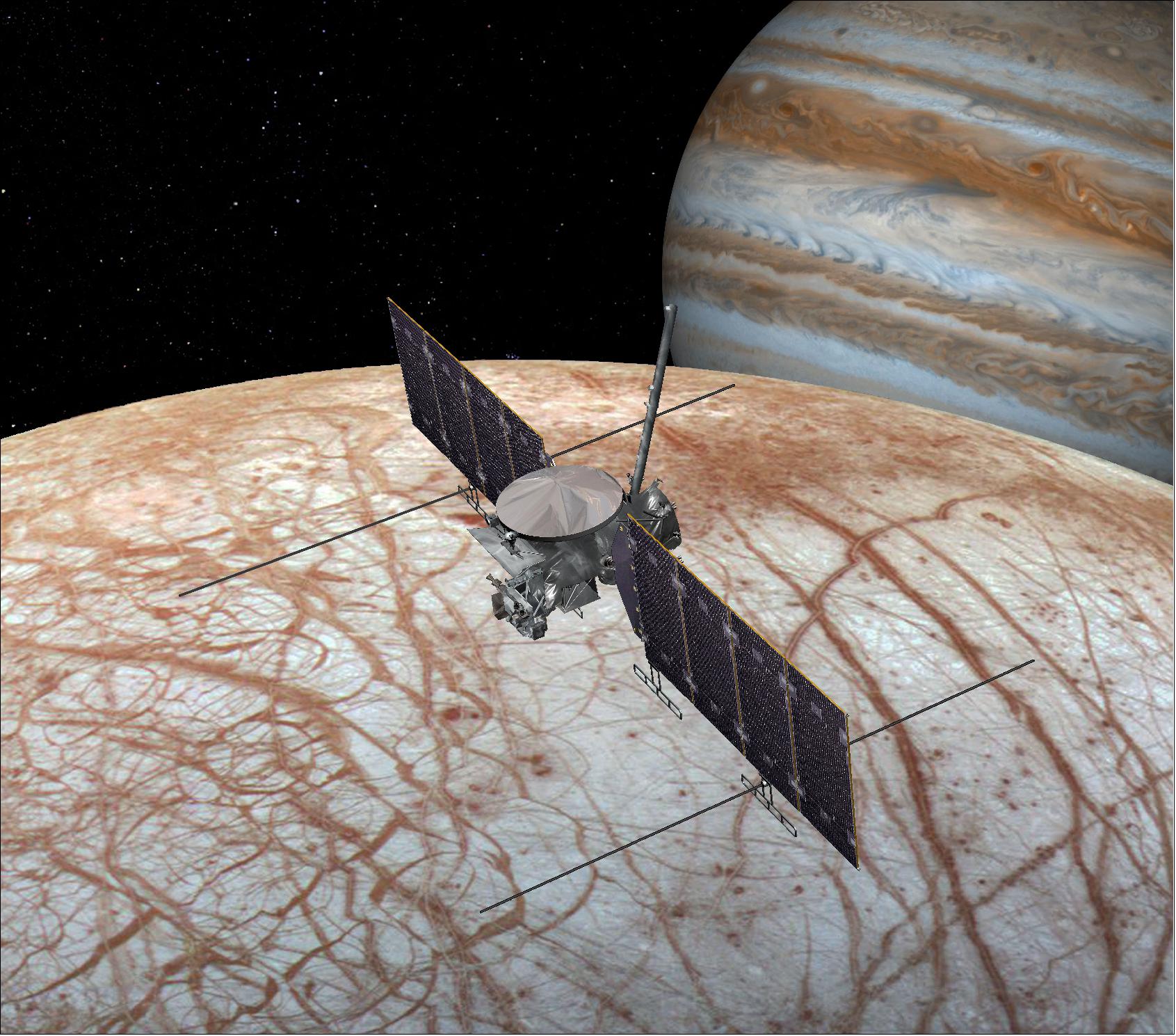
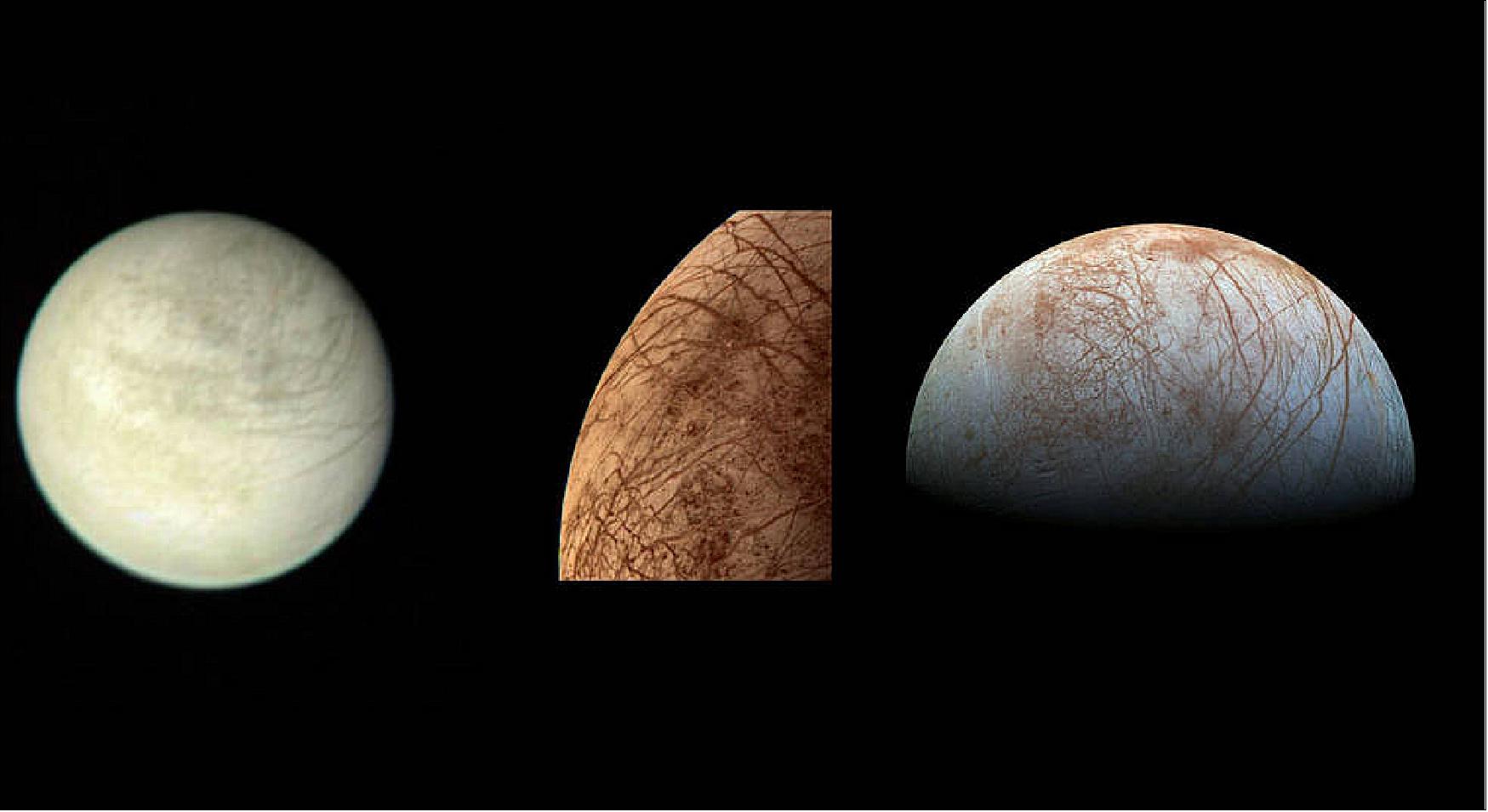
They used a spectrograph at the Keck Observatory that measures the chemical composition of planetary atmospheres through the infrared light they emit or absorb. Molecules such as water emit specific frequencies of infrared light as they interact with solar radiation.
Mounting Evidence for Water
Before the recent water vapor detection, there have been many tantalizing findings on Europa. The first came from NASA's Galileo spacecraft, which measured perturbations in Jupiter's magnetic field near Europa while orbiting the gas giant planet between 1995 and 2003. The measurements suggested to scientists that electrically conductive fluid, likely a salty ocean beneath Europa's ice layer, was causing the magnetic disturbances. When researchers analyzed the magnetic disturbances more closely in 2018, they found evidence of possible plumes.
In the meantime, scientists announced in 2013 that they had used NASA's Hubble Space Telescope to detect the chemical elements hydrogen (H) and oxygen (O) — components of water (H2O) — in plume-like configurations in Europa's atmosphere. And a few years later, other scientists used Hubble to gather more evidence of possible plume eruptions when they snapped photos of finger-like projections that appeared in silhouette as the moon passed in front of Jupiter.
"This first direct identification of water vapor on Europa is a critical confirmation of our original detections of atomic species, and it highlights the apparent sparsity of large plumes on this icy world" said Lorenz Roth, an astronomer and physicist from KTH Royal Institute of Technology in Stockholm who led the 2013 Hubble study and was a co-author of this recent investigation.
Roth's research, along with other previous Europa findings, have only measured components of water above the surface. The trouble is that detecting water vapor at other worlds is challenging. Existing spacecraft have limited capabilities to detect it, and scientists using ground-based telescopes to look for water in deep space have to account for the distorting effect of water in Earth's atmosphere. To minimize this effect, Paganini's team used complex mathematical and computer modeling to simulate the conditions of Earth's atmosphere so they could differentiate Earth's atmospheric water from Europa's in data returned by the Keck spectrograph.
"We performed diligent safety checks to remove possible contaminants in ground-based observations," said Avi Mandell, a Goddard planetary scientist on Paganini's team. "But, eventually, we'll have to get closer to Europa to see what's really going on."
Scientists will soon be able get close enough to Europa to settle their lingering questions about the inner and outer workings of this possibly habitable world. The forthcoming Europa Clipper mission, expected to launch in the mid-2020s, will round out half a century of scientific discovery that started with a modest photo of a mysterious, veiny eyeball.
When it arrives at Europa, the Clipper orbiter will conduct a detailed survey of Europa's surface, deep interior, thin atmosphere, subsurface ocean, and potentially even smaller active vents. Clipper will try to take images of any plumes and sample the molecules it finds in the atmosphere with its mass spectrometers. It will also seek out a fruitful site from which a future Europa lander could collect a sample. These efforts should further unlock the secrets of Europa and its potential for life.
Other Goddard researchers on Paganini's team included Geronimo Villanueva, Michael Mumma, and Terry Hurford. Kurt Retherford, from Southwest Research Institute, also contributed to the research.
Launch
NASA has selected SpaceX to provide launch services for Earth's first mission to conduct detailed investigations of Jupiter's moon Europa. The Europa Clipper mission will launch in October 2024 on a Falcon Heavy rocket from Launch Complex 39A at NASA's Kennedy Space Center in Florida. The total contract award amount for launch services is approximately $178 million. 3)
Spacecraft
The spacecraft is being developed to study the Galilean moon Europa through a series of flybys while in orbit around Jupiter.
August 2021: The hardware that makes up NASA's Europa Clipper spacecraft is rapidly taking shape, as engineering components and instruments are prepared for delivery to the main clean room at the agency's Jet Propulsion Laboratory in Southern California. In workshops and labs across the country and in Europe, teams are crafting the complex pieces that make up the whole as mission leaders direct the elaborate choreography of building a flagship mission. 4)
The massive 10-foot-tall (3-meter-tall) propulsion module recently moved from NASA's Goddard Space Flight Center in Greenbelt, Maryland, to the Johns Hopkins Applied Physics Laboratory (APL) in Laurel, Maryland, where engineers will install electronics, radios, antennas, and cabling. The spacecraft's thick aluminum vault, which will protect Europa Clipper's electronics from Jupiter's intense radiation, is nearing completion at JPL. The building and testing of the science instruments at universities and partner institutions across the country continue as well.
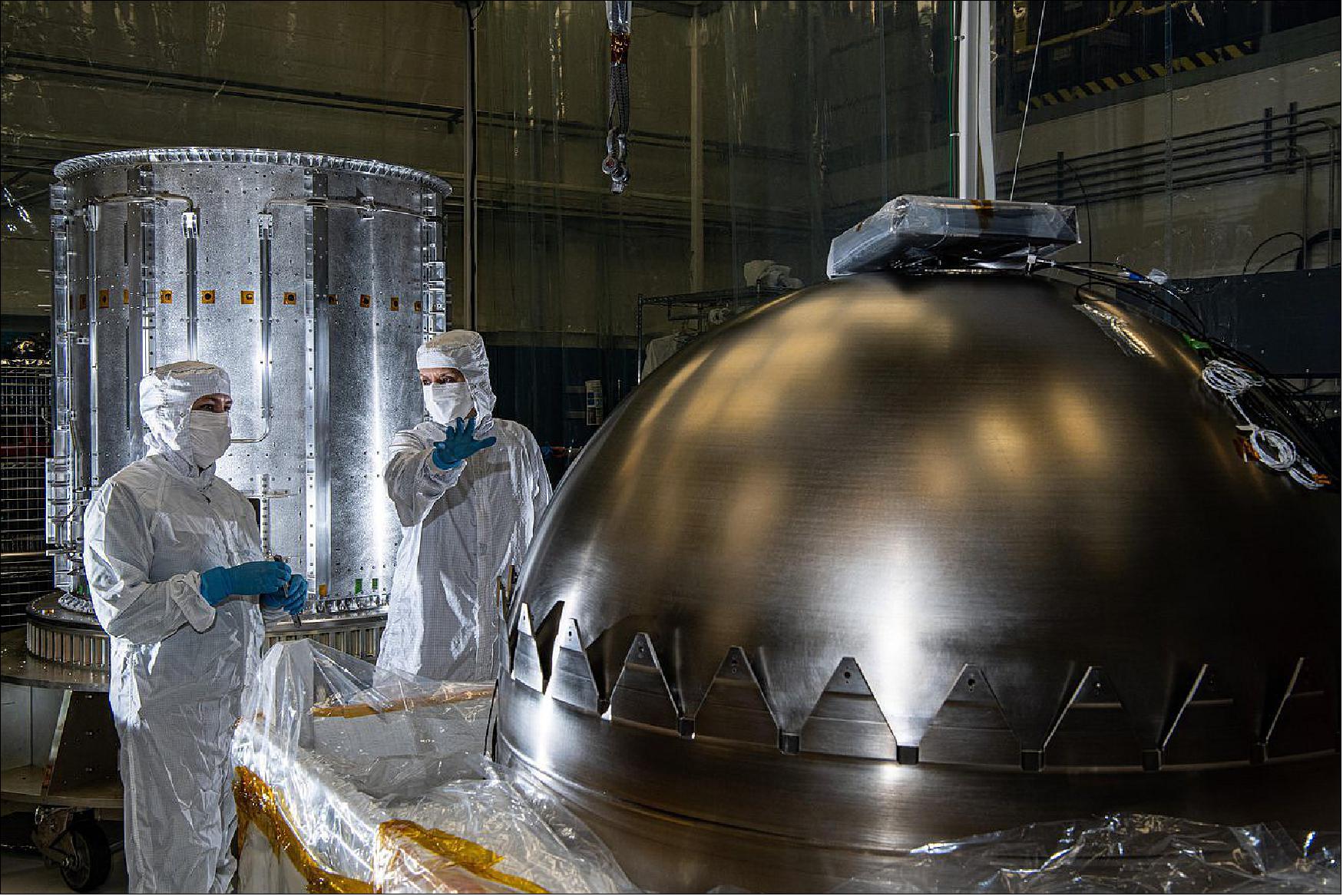
The mission is also gearing up for its System Integration Review in late 2021, when NASA will review plans for assembling and testing Europa Clipper, and its instruments are inspected in detail.
"It's really exciting to see the progression of flight hardware moving forward this year as the various elements are put together bit by bit and tested," said Europa Clipper Project Manager Jan Chodas of JPL. "The project team is energized and more focused than ever on delivering a spacecraft with an exquisite instrument suite that promises to revolutionize our knowledge of Europa."
Jupiter's icy moon Europa, which harbors an internal ocean with twice the amount of water in Earth's oceans combined, may currently have conditions suitable for supporting life. Europa Clipper will carry a broad suite of science instruments into orbit around Jupiter and conduct multiple close flybys of Europa to gather data on its atmosphere, surface, and interior.
Hardware in the Works
Delivery of the towering propulsion module from Goddard to APL marked a milestone for that major piece of hardware. APL built the twin cylinders that make up the module and shipped them to JPL, where technicians added thermal tubing that will carry coolant to keep the spacecraft from getting too hot or too cold in deep space. From there, the cylinders went to Goddard, where propellant tanks were installed inside of them and 16 rocket engines were attached to the outside.
Another large piece of hardware nearing completion is the spacecraft's radiator, which connects to the thermal tubing. The width and length of a twin-size bed, the radiator's 3-inch-thick (7.5-cm-thick) panel has the crucial job of radiating heat out into space to keep the spacecraft within its operating temperature range. It is covered with louvers that open and close automatically as the spacecraft disperses more or less heat to regulate its temperature.
Meanwhile, work at APL begins to integrate the propulsion module and the telecommunications hardware (electronics, radios, antennas, and cabling). And construction of a high-gain antenna – a dish nearly 10 feet (3 meters) wide – is underway at vendor Applied Aerospace Structures Corporation in Stockton, California. It will be delivered to APL this year, where it will be integrated before the entire module comes back to JPL a final time. By the spring of 2022, the huge element will join other Europa Clipper hardware streaming into JPL's main high bay for ATLO (Assembly, Test, and Launch Operations).
One of the first elements in place for ATLO will be the spacecraft's vault, now entering its final stage of fabrication at JPL. Eventually, the vault will be bolted to the top of the propulsion module and affixed with miles of cabling so that the power box and computer inside can communicate with the other subsystems.
Attached to the vault will be a deck, also completing assembly at JPL, that will support many of the instrument sensors. Called the nadir deck, it stabilizes the spacecraft's sensors and helps ensure they are oriented correctly.
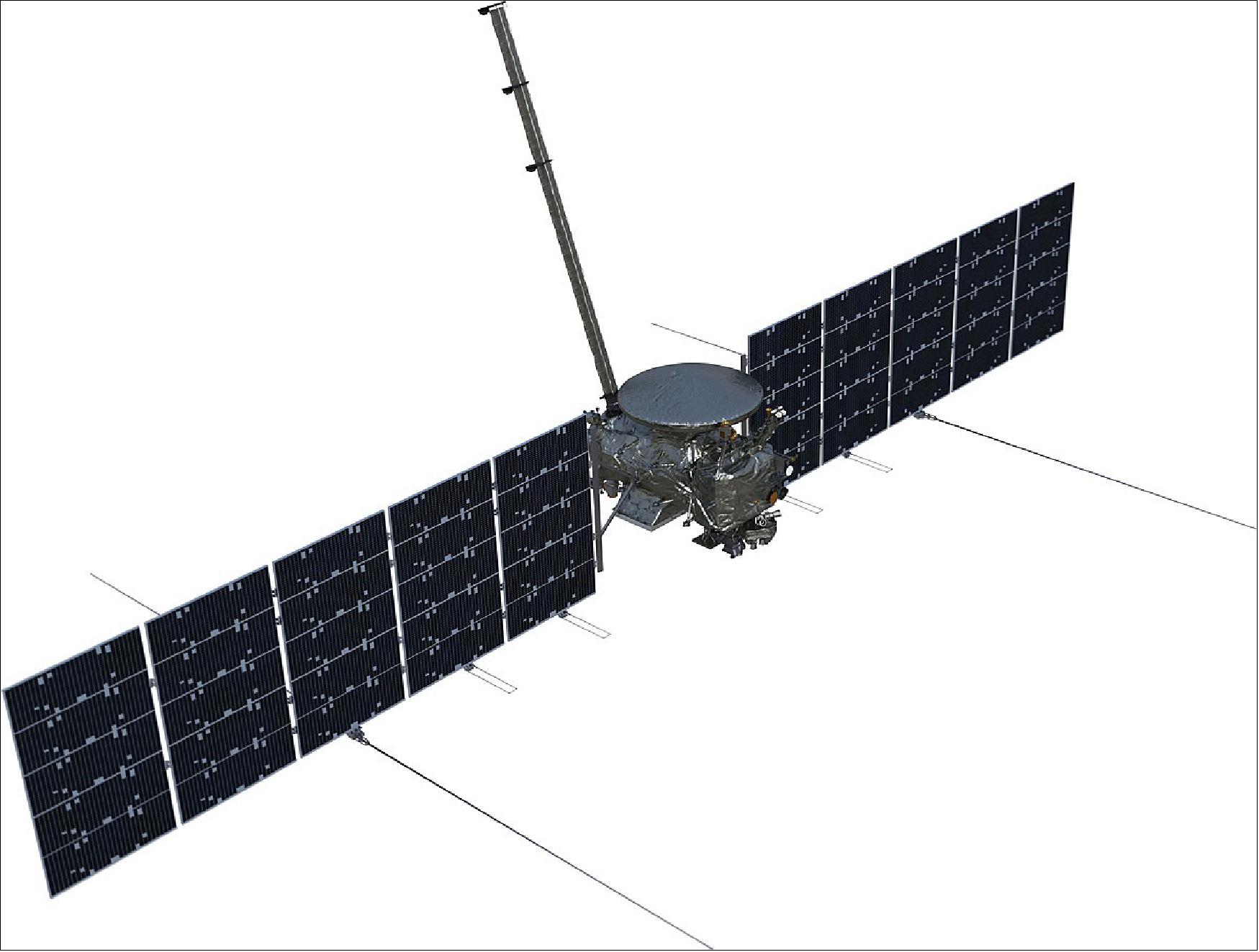
At launch, Europa Clipper has a mass of ~6000 kg, about 65% of which will be fuel. Its solar panels will span about 30 m – wider than the length of a basketball court. The spacecraft will fly by Mars, then Earth, stealing orbital momentum from each. These gravity assists provide Europa Clipper with the velocity needed to reach Jupiter. 5)
In Jupiter orbit, Europa Clipper will spend about one year altering its trajectory to prepare for its Europa flyby. The spacecraft will then spend three years soaring past Europa 45 times or so. After each flyby, the spacecraft will send its data back to Earth. Over the course of the mission, the spacecraft will scan almost the entire moon, at a variety of resolutions.
A metal box known as a radiation vault will shield Europa Clipper's electronics from Jupiter's harsh radiation. The vault's walls are an aluminum alloy about 0.3 inches (9.2 mm) thick.
Development Status
• June 7, 2022: The agency's mission to explore Jupiter's icy moon takes a big step forward as engineers deliver a major component of the spacecraft. 6)
- The main body of NASA's Europa Clipper spacecraft has been delivered to the agency's Jet Propulsion Laboratory in Southern California. Over the next two years there, engineers and technicians will finish assembling the craft by hand before testing it to make sure it can withstand the journey to Jupiter's icy moon Europa.
- The spacecraft body is the mission's workhorse. Standing 10 feet (3 meters) tall and 5 feet (1.5 meters) wide, it's an aluminum cylinder integrated with electronics, radios, thermal loop tubing, cabling, and the propulsion system. With its solar arrays and other deployable equipment stowed for launch, Europa Clipper will be as large as an SUV; when extended, the solar arrays make the craft the size of a basketball court. It is the largest NASA spacecraft ever developed for a planetary mission.
- "It's an exciting time for the whole project team and a huge milestone," said Jordan Evans, the mission's project manager at JPL. "This delivery brings us one step closer to launch and the Europa Clipper science investigation."
- Set to launch in October 2024, Europa Clipper will conduct nearly 50 flybys of Europa, which scientists are confident harbors an internal ocean containing twice as much water as Earth's oceans combined. And the ocean may currently have conditions suitable for supporting life. The spacecraft's nine science instruments will gather data on Europa's atmosphere, surface, and interior – information that scientists will use to gauge the depth and salinity of the ocean, the thickness of the ice crust, and potential plumes that may be venting subsurface water into space.
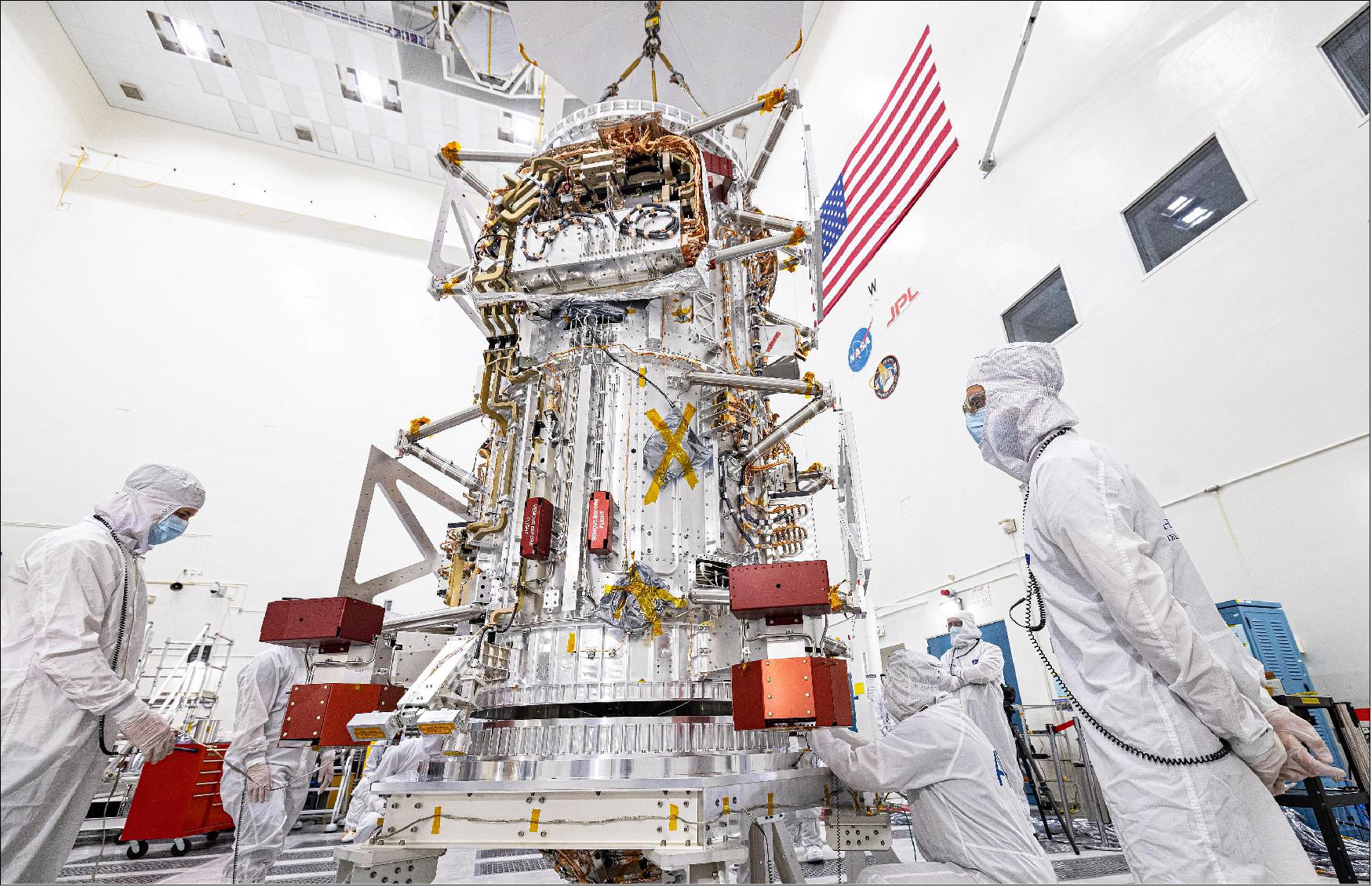
- Those instruments already have begun arriving at JPL, where the phase known as assembly, test, and launch operations has been underway since March. The ultraviolet spectrograph, called Europa-UVS, arrived in March. Next came the spacecraft's thermal emission imaging instrument, E-THEMIS, delivered by the scientists and engineers leading its development at Arizona State University. E-THEMIS is a sophisticated infrared camera designed to map Europa's temperatures and help scientists find clues about the moon's geological activity – including regions where liquid water may be near the surface.
- By the end of 2022, most of the flight hardware and the remainder of the science instruments are expected to be complete.
The Whole Package
- The Johns Hopkins Applied Physics Laboratory (APL) in Laurel, Maryland, designed Europa Clipper's body in collaboration with JPL and NASA's Goddard Space Flight Center in Greenbelt, Maryland. "The flight system designed, built, and tested by APL – using a team of hundreds of engineers and technicians – was the physically largest system ever built by APL," said APL's Tom Magner, the mission's assistant project manager.
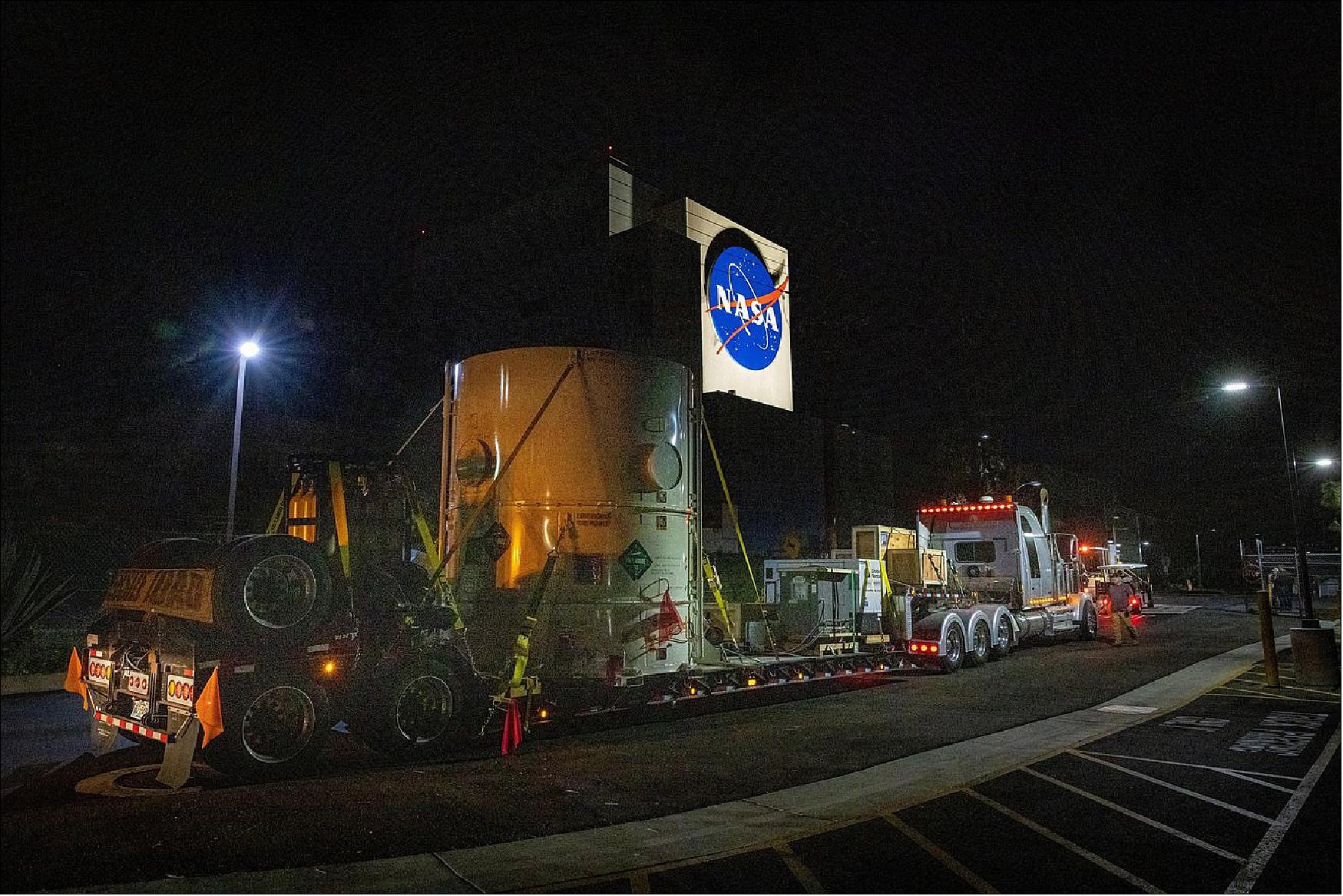
- The work on the main module continues now at JPL.
- "What arrived at JPL represents essentially an assembly phase unto itself. Under APL's leadership, this delivery includes work by that institution and two NASA centers. Now the team will take the system to an even higher level of integration," said Evans.
- The main structure is actually two stacked aluminum cylinders dotted with threaded holes for bolting on the spacecraft's cargo: the radio frequency module, radiation monitors, propulsion electronics, power converters, and wiring. The radio frequency subsystem will power eight antennas, including an enormous high-gain antenna that measures 10 feet (3 meters) wide. The structure's web of electrical wires and connectors, called the harness, weighs 150 pounds (68 kg) by itself; if stretched out, it would run almost 2,100 feet (640 meters) – twice the perimeter of a football field.
- The heavy-duty electronics vault, built to withstand the intense radiation of the Jupiter system, will be integrated with the main spacecraft structure along with the science instruments.
- Inside the main body of the spacecraft are two tanks – one to hold fuel, one for oxidizer – and the tubing that will carry their contents to an array of 24 engines, where they will combine to create a controlled chemical reaction that produces thrust.
- "Our engines are dual purpose," said JPL's Tim Larson, the deputy project manager. "We use them for big maneuvers, including when we approach Jupiter and need a large burn to be captured in Jupiter's orbit. But they're also designed for smaller maneuvers to manage the attitude of the spacecraft and to fine tune the precision flybys of Europa and other solar system bodies along the way."
- Those big and small maneuvers will come into play a lot during the six-year, 1.8-billion-mile (2.9-billion-kilometer) journey to this ocean world, which Europa Clipper will begin investigating in earnest in 2031.
• April 25, 2022: Parallel ice ridges, a common feature on Jupiter's moon Europa, are found on Greenland's ice sheet – and could bode well for Europa's potential habitability. 7)
- Parallel ice ridges in Greenland bear a striking resemblance to ridges on Jupiter's ice-encased moon Europa, suggesting the moon's icy shell could be riddled with pockets of water.
- This similarity could greatly improve the odds of NASA's Europa Clipper mission detecting potentially habitable environments on the Jovian moon. The spacecraft's ice-penetrating radar instrument REASON (Radar for Europa Assessment and Sounding: Ocean to Near-surface) will be ideal for conducting such a search.
- "If there are pockets of water under the ridges, we have the right instruments to see them," said Dustin Schroeder, a Stanford University associate professor and coauthor of a new study comparing Greenland's "double ridges" with those of Europa. 8)
- Scientists say evidence gathered so far shows that Europa harbors a deep liquid ocean, hidden beneath an ice shell that could be 10 to 15 miles (15 to 25 km) thick. Because the ice is so substantial, a big question about the moon is whether anything from the deep ocean makes contact with the surface – or if contact goes the other way, with surface material filtering down to the ocean water.
- "It's exciting, what it would mean if you have plenty of water within the ice shell," said coauthor Gregor Steinbrügge, a former Stanford researcher who is now a planetary scientist at NASA's Jet Propulsion Laboratory in Southern California. "It would mean the ice shell on Europa is extremely dynamic. It could facilitate exchange processes between the surface and the subsurface ocean. It could go in both directions."
- Potential life-sustaining nutrients on Europa's surface – perhaps deposited there by another Jupiter moon, volcanic Io – might find their way to the subsurface ocean, he said. And chemicals or other material from the subsurface indicating a habitable ocean environment could end up on the surface.
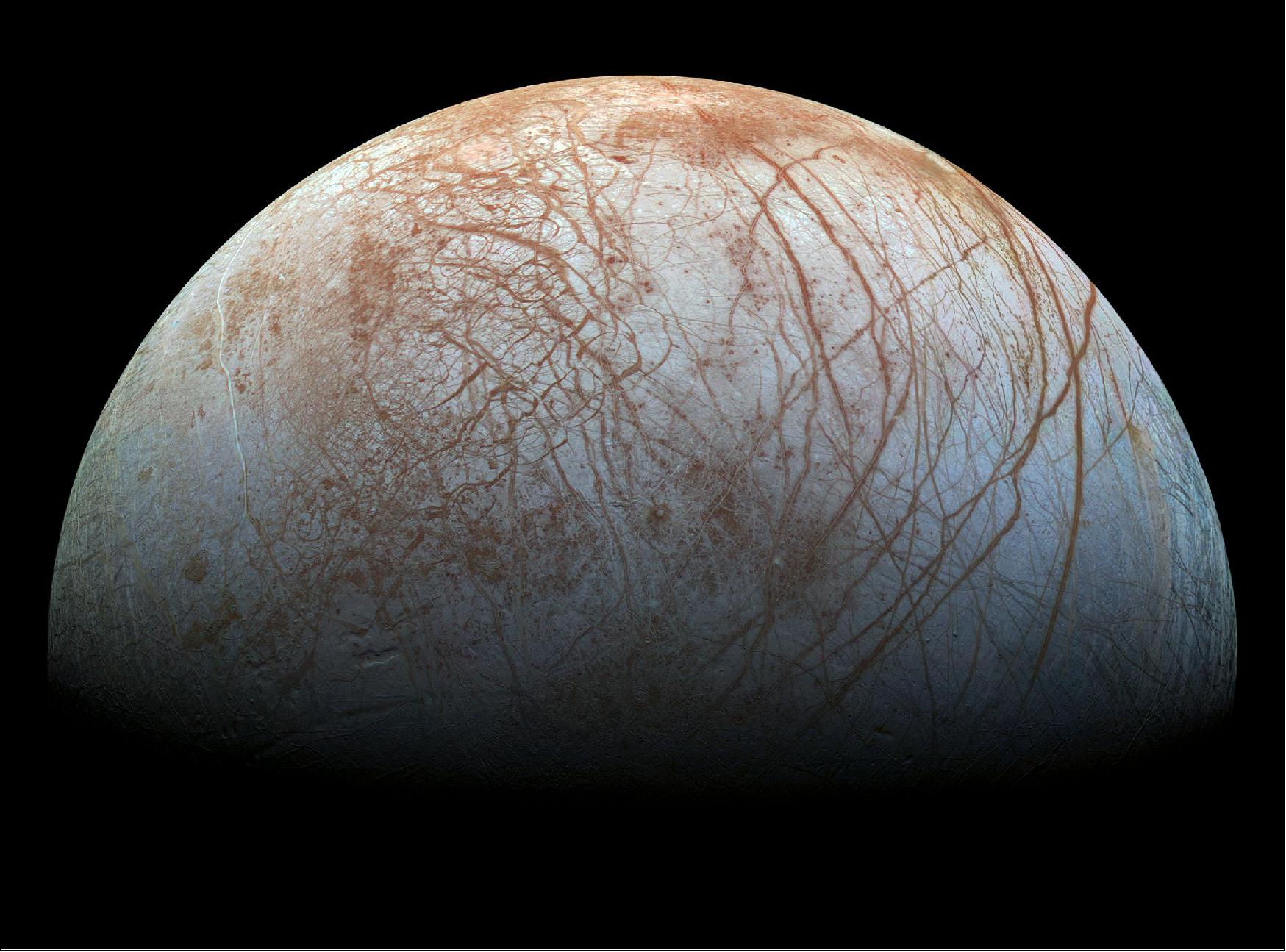
How Ridges May Have Formed
- During a presentation on Europa's ridges, the study's lead author, Stanford graduate student Riley Culberg, said he noticed similar landforms in Greenland. Ice-penetrating radar data collected from 2015 to 2017 by NASA's Operation IceBridge, an aerial observation campaign, showed not only the existence of a double ridge in northwestern Greenland, but also details of how it evolved.
- The double ridges observed on the surface of the Greenland Ice Sheet formed when water from nearby surface lakes drained into a layer of impermeable ice within the ice sheet. Once there, the water pocket refroze and fractured the overlying ice, forcing peaks to rise on either side.
- Something similar could be happening on Europa, but instead with water forced up toward the surface from the subsurface ocean. The ridge features on Europa, while similar to the Greenland ridges, are much larger and with taller peaks, perhaps due in part to lower gravity on Europa.
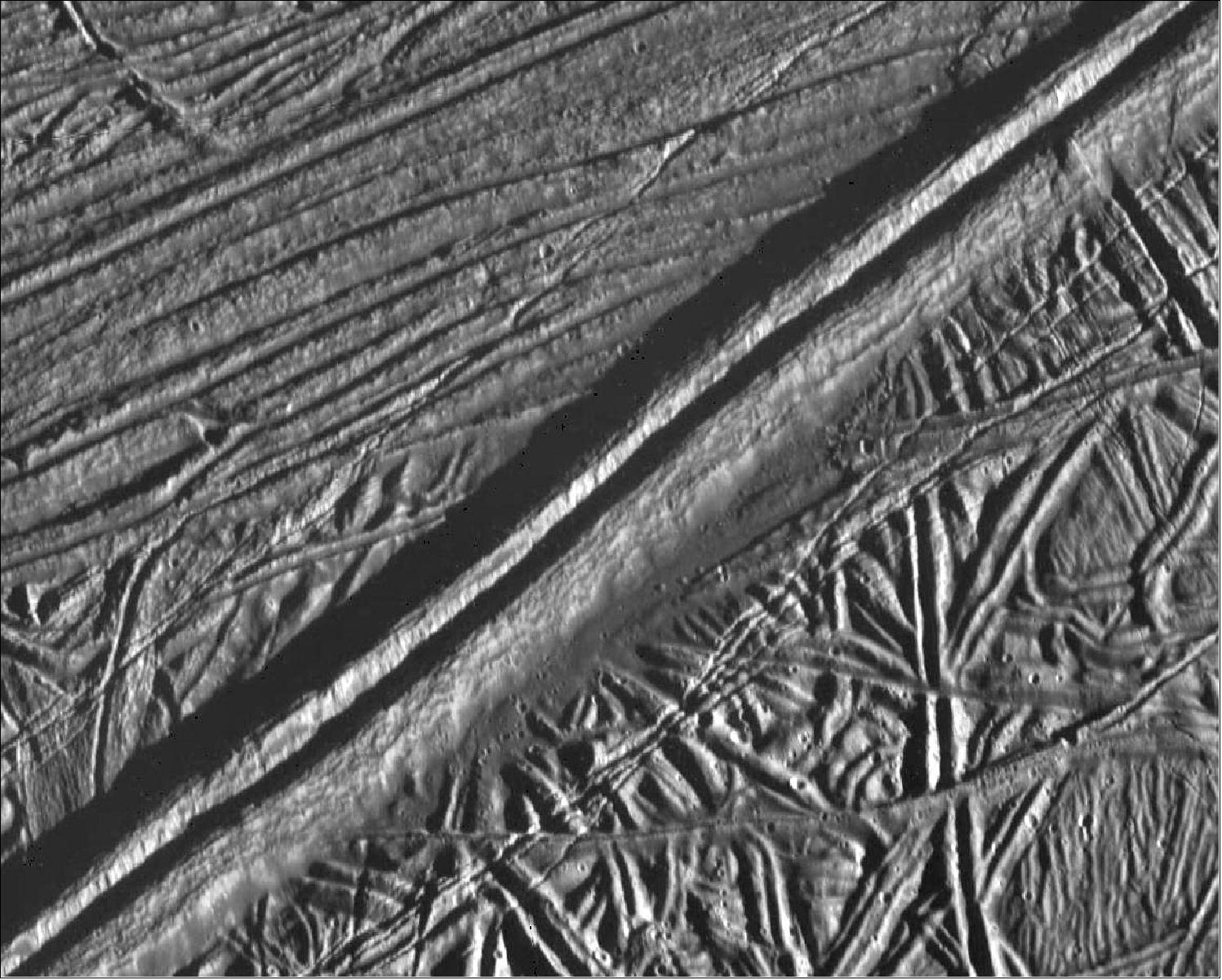
- Europa Clipper's REASON instrument is designed to make the same kind of measurements at Europa that the IceBridge radar made in Greenland. Both use radio waves that can penetrate deeply into ice. The same waves, however, cannot penetrate liquid water and are instead reflected back to the radar instrument. Water shows up as a bright patch in the radar images. These radargrams can therefore provide a vertical profile of water and ice deep below the surface.
- "You get reflections that are a thousand times brighter for water as opposed to ice," Schroeder said.
- Schroeder, a co-investigator on REASON and part of a group that studies Europa's interior, said the new study could help the Europa Clipper team design observations to determine whether the ridges on the moon and in Greenland arose from the same underlying causes – and whether water pockets are common within Europa's icy shell.
- The study also highlights the growing synergy between scientists who study our planetary neighbors in the solar system and those who focus on Earth.
- "This research will help us either use Earth to understand what we will see on Europa or, when we get to Europa, help us interpret what we see when we get there," Schroeder said.
• March 3, 2022: Science instruments and other hardware for the spacecraft will come together in the mission's final phase before a launch to Jupiter's icy moon Europa in 2024. 9)
- When it's fully assembled, NASA's Europa Clipper will be as large as an SUV (Sport Utility Vehicle) with solar arrays long enough to span a basketball court – all the better to help power the spacecraft during its journey to Jupiter's icy moon Europa. And just about every detail of the spacecraft will have been hand-crafted.
- The assembly effort is already underway in clean rooms at the agency's Jet Propulsion Laboratory in Southern California. Now, engineering components and science instruments are beginning to stream in from across the country and Europe. Before year's end, most of the flight hardware – including a suite of nine science instruments – is expected to be complete.
- The main body of the spacecraft is a giant 10-foot-tall (3-meter-tall) propulsion module, designed and constructed by Johns Hopkins Applied Physics Laboratory (APL) in Laurel, Maryland, with help from NASA's Goddard Space Flight Center in Greenbelt, Maryland, and JPL. The module, fitted with electronics, radios, cabling, and the propulsion subsystem, will ship to JPL this spring. Europa Clipper's 10-foot-wide (3-meter-wide) high-gain antenna also will be arriving at the Lab soon.
- "We're moving into the phase where we see the pieces all come together as a flight system," said Europa Clipper Project Manager Jan Chodas of JPL. "It will be very exciting to see the hardware, the flight software, and the instruments get integrated and tested. To me, it's the next level of discovery. We'll learn how the system we designed will actually perform."
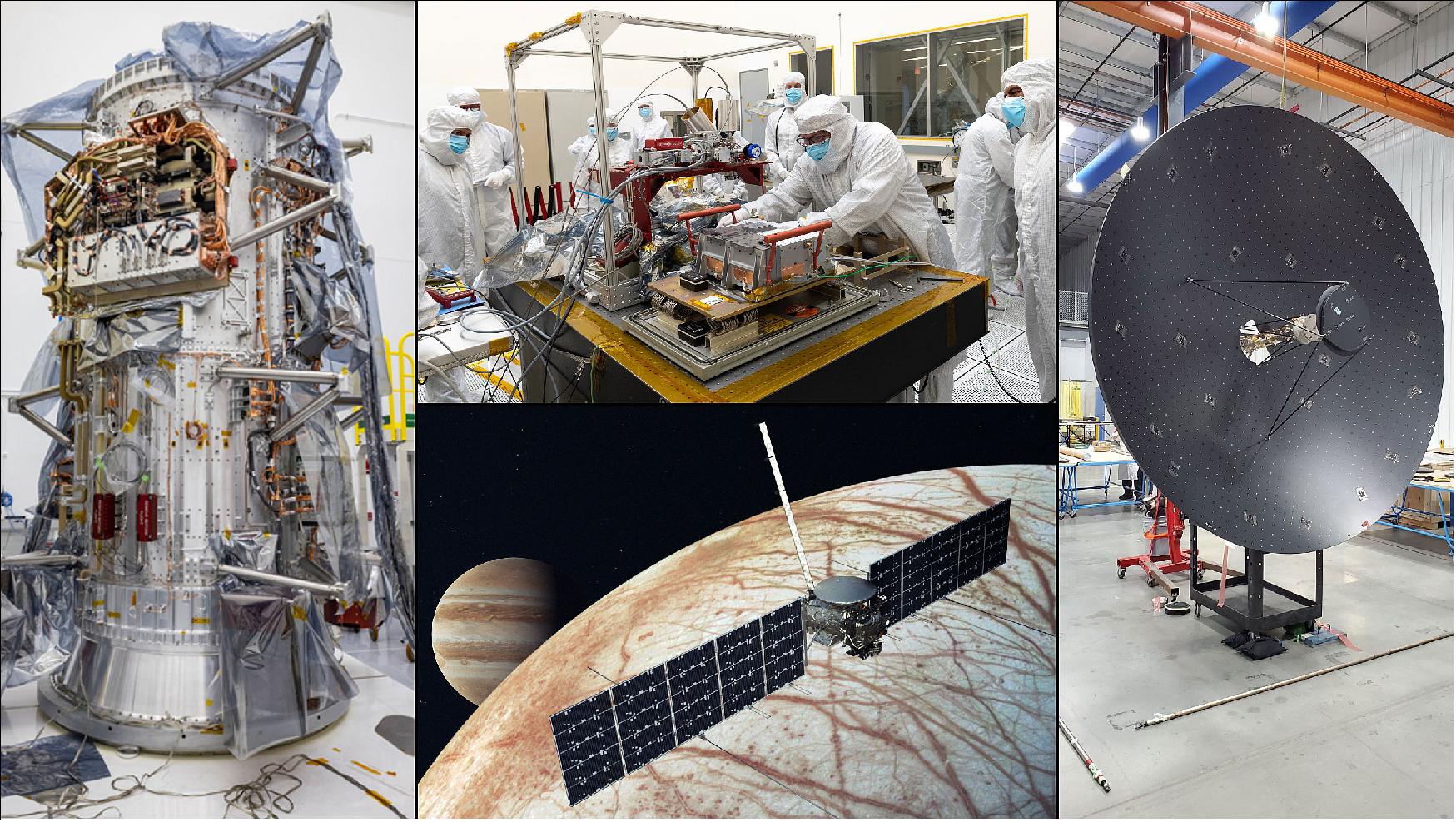
• January 10, 2022: ASU scientists and engineers building the Europa Thermal Emission Imaging System (E-THEMIS) for NASA's Europa Clipper passed a major hurdle recently by capturing the first successful test images from this complex infrared camera, known as "first light" images. 10)
- Europa Clipper, a NASA mission to investigate Jupiter's moon Europa, is planned to launch in October 2024 and arrive at Jupiter in 2030. It will study this icy moon through a series of flybys while in orbit around Jupiter to investigate whether it could harbor conditions suitable for life.
- E-THEMIS, which is led by Regents Professor Philip Christensen of Arizona State University's School of Earth and Space Exploration, is an infrared camera designed to map Europa's temperatures for the mission. These infrared images will help scientists seek clues about Europa's activity, including regions where Europa's suspected ocean may be near the surface.
- "The surface of Europa is extremely cold, but the ocean underneath is warm, liquid water. If that water is coming near the surface through cracks and vents, E-THEMIS will see these warm regions and tell us where ocean water is closest to the surface," Christensen said. "Even if water erupted onto the surface many years ago, the ice will still be warm. From these temperature images, E-THEMIS will provide an excellent opportunity to study the geologic activity of Europa."
- The "first light" E-THEMIS camera test images were taken from the rooftop of the Interdisciplinary Science and Technology Building 4 (ISTB4) on the ASU Tempe campus using a specially designed mobile cleanroom laboratory, which kept the camera safe from dust, microbes and aerosol particles.
- "Our team spent months developing a portable clean lab to safely transport E-THEMIS to the roof of the building and collect data in a controlled environment," Christensen said.
- One of the most spectacular test images produced from E-THEMIS is a temperature image taken looking north from ISTB4. In stunning detail, the image clearly shows ASU's Sun Devil Stadium and "A" Mountain, among other recognizable ASU landmarks. It is even possible to read details inside the stadium from the E-THEMIS instrument, based on temperature differences sensed from about 1.1 km (0.7 miles) away.
- "The instrument worked beautifully and is in excellent focus," Christensen said.
- During this test, the E-THEMIS team also collected temperature images throughout the afternoon and early evening. When displayed in color, these images reveal how the temperature changes as evening approaches. The red, orange and yellow colors in the images indicate warmer temperatures due to heat and the infrared radiation being emitted. The purples and dark blues indicate cooler temperatures, with less heat and infrared radiation emitted.
- While the temperatures are approximations during this testing phase, the progression of cooler colors (purples and blues) from afternoon to evening in the three images, acquired at 12:40 p.m., 4:40 p.m. and 6:20 p.m., after sunset, illustrate how the infrared camera detected surface temperatures transitioning from warmer in the afternoon to cooler after sunset.
- With this successful "first light" testing of E-THEMIS, the next step for the team is to begin the environmental testing to ensure that E-THEMIS will survive launch and operate as intended in space.
- "Launch is one of the most stressful periods for any spacecraft or instrument, and we want to make sure E-THEMIS will survive, so we will put it through a rigorous set of vibration tests to simulate the launch conditions," Christensen said. "We will also test it in a vacuum chamber to make sure it will work properly in the vacuum of space."
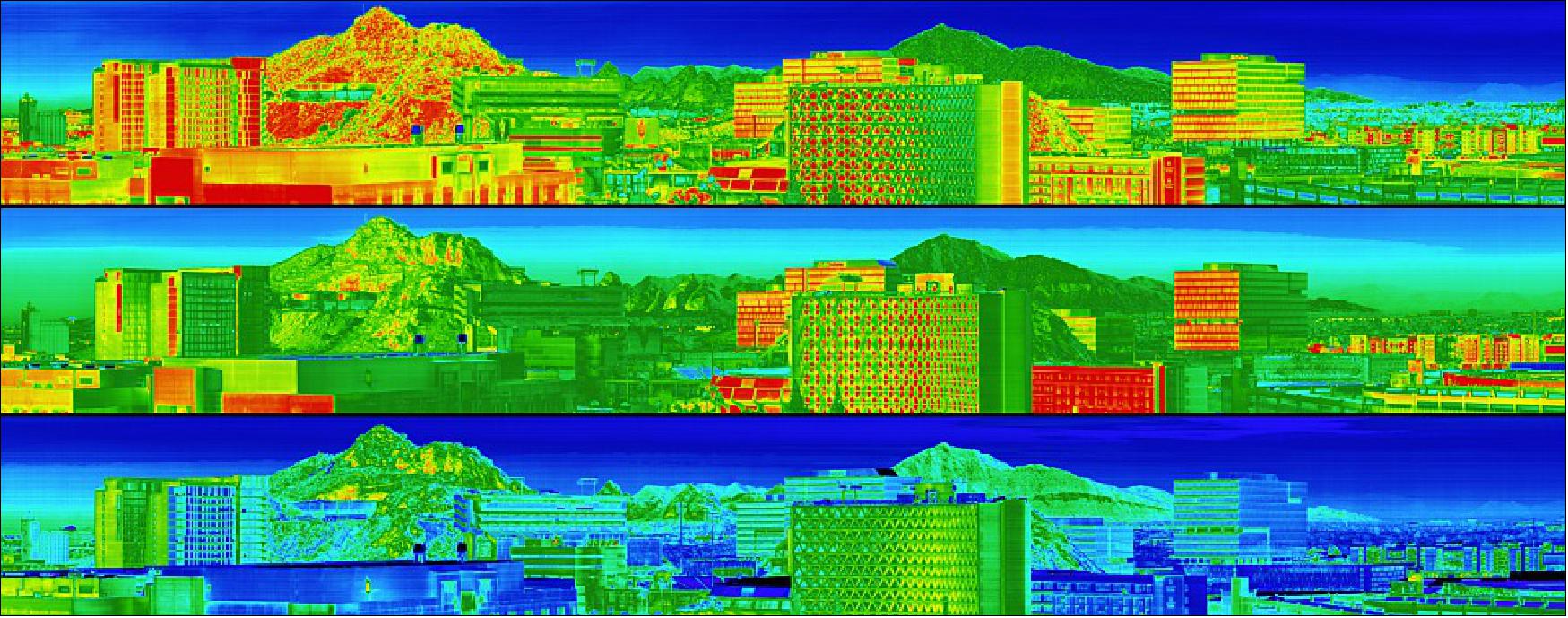
• November 30, 2021: In 2005, images of a brilliant watery plume erupting from the surface of Saturn's moon Enceladus captivated the world. The giant column of vapor, ice particles, and organic molecules spraying from the moon's south polar region suggested that there's a liquid water ocean below Enceladus' ice shell and confirmed the moon is geologically active. The plume also thrust Enceladus and other worlds in the outer solar system, with no atmospheres and far from the heat of the Sun, toward the top of NASA's list of places to search for signs of life. 11)
- Scientists now are preparing for a mission to another ice-covered ocean world with possible plumes: Jupiter's moon Europa. Scheduled to launch in 2024, NASA's Europa Clipper spacecraft will study the moon from its deep interior to its surface to determine whether it has ingredients that make it a viable home for life.
- Like Enceladus, Europa is geologically dynamic, meaning both moons generate heat inside as their solid layers stretch and flex from the gravitational tug-of-war with their host planets and neighboring moons. This, instead of heat from the Sun, keeps subsurface water from freezing on these ice-covered moons. The heat may also help produce or circulate life's chemical building blocks at the seafloors, including carbon, hydrogen, oxygen, nitrogen, phosphorus, and sulfur.
- But that's where the similarities end.
- "A lot of people think Europa is going to be Enceladus 2.0, with plumes constantly spraying from the surface," said Lynnae Quick, a member of the science team behind Clipper's Europa Imaging System (EIS) cameras. "But we can't look at it that way; Europa is a totally different beast," said Quick, who's based at NASA's Goddard Space Flight Center in Greenbelt, Maryland.
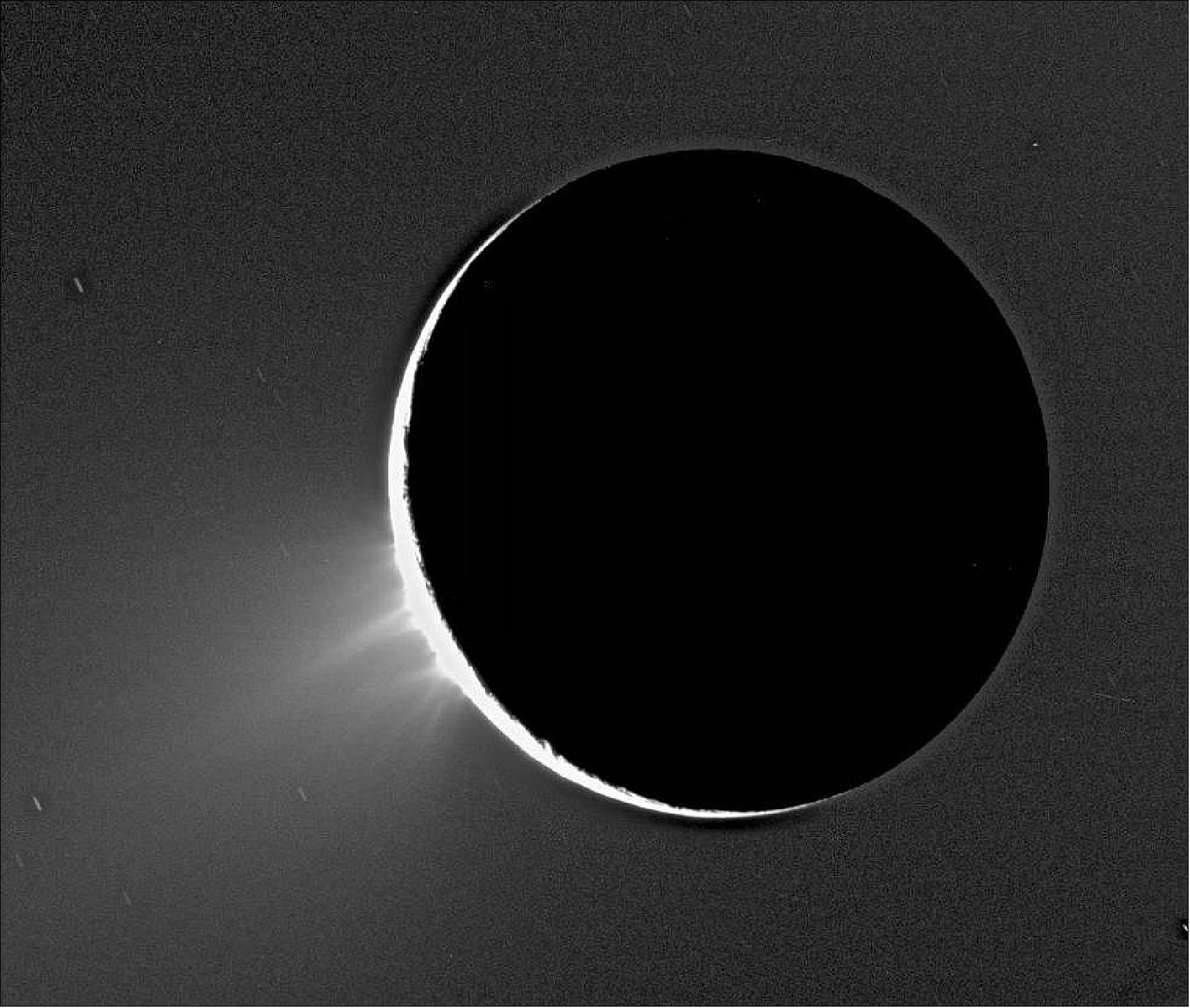
- Evidence suggests Europa may vent water from its subsurface just like Enceladus. For example, scientists using NASA's Galileo spacecraft, NASA's Hubble Telescope, and large Earth-based telescopes have reported detections of faint water plumes or their chemical components at Europa.
- But no one is certain. "We're still in the space where there's really intriguing evidence but none of it is a slam dunk," said Matthew McKay Hedman, a member of Europa Clipper's Mapping Imaging Spectrometer for Europa (MISE) science team and associate professor in the Department of Physics at the University of Idaho.
- Scientists are drawn to plumes for a couple of reasons. First, they're undeniably cool: "We're scientists, but we're also human," said Shawn Brooks, who is working with Europa Clipper's Europa Ultraviolet Spectrograph (Europa-UVS) science team and is based at NASA's Jet Propulsion Laboratory in Southern California.
- But more practically, Brooks said, plumes offer scientists easier access to Europa's interior. "It all comes down to whether Europa is habitable, and that comes down to having some understanding of what is happening below the surface, which we can't reach yet," he said.
- In other words, the magic of Europa, an archetype for a potentially habitable world, is hidden from view deep within the moon. Compared to Enceladus, which is the size of Texas, Europa is about a quarter of Earth's size, or a bit smaller than Earth's moon. And evidence suggests Europa has a much deeper saltwater ocean than Enceladus, possibly 40 to 100 miles (about 60 to 160 km) deep, which means it could contain about twice as much water as Earth's oceans. Some scientists hypothesize that Europa's ocean could be reacting with superheated rocks below its seafloor, possibly through hydrothermal vents. On Earth, such areas are hotbeds of chemical activity that nourishes innumerable creatures.
- Scientists say there also could be large pockets of melted water in Europa's ice shell, which are more likely than the ocean to be the source of plumes. These pockets could produce cozy habitats for organisms as well.
- Because it's much closer to Jupiter than Enceladus is to Saturn, more heat is generated at Europa from friction produced as it circles its host planet. Given that internal heat stimulates geological activity on rocky worlds, Europa is expected to have more extensive geology than Enceladus. Some scientists predict that Europa has plate tectonics that shift and recycle the icy blocks making up the moon's surface. If so, Europa could be circulating nutrients produced on the surface by radiation from Jupiter, such as oxygen, to pockets of liquid in the ice shell or perhaps to the ocean itself. Through Europa Clipper, scientists will have a chance to test some of their predictions by analyzing the chemical makeup of plumes or the traces they may leave on the surface.
- Scientists warn that Europan plumes, even if they're there, could be hard to detect even from up close. They may be sporadic, and they may be small and thin, given that Europa's gravity, which is much stronger than Enceladus', likely would keep these water plumes close to the surface. That's a drastic departure from Enceladus' spectacular vapor column: It's always on and bigger than the moon itself, spraying icy particles hundreds of miles above the surface. "Even if they're there, Europa's plumes may not be that photogenic," Hedman said.
- Though Europa Clipper scientists are devising a variety of creative strategies to find active plumes when the spacecraft begins exploring Europa in 2031, they're not relying on them to understand what's going on inside the moon. "We don't have to catch one for a successful mission," Quick said.
- Quick added that every instrument aboard Clipper can contribute evidence of habitable conditions below the surface regardless of active plumes.
- A few examples of how the science team will search for potential plumes include Europa Clipper's camera suite, EIS. It will scout for plumes near Europa's surface partly by looking for their silhouettes at Europa's limb, or edge, when the moon is illuminated by the light of Jupiter as it passes in front of the planet. EIS will snap photos of plumes should they appear, as well as plume deposits that might be visible on the surface. The Europa-UVS will also strive to detect plumes in ultraviolet light, including at the edge of the moon when Europa passes in front of nearby stars, and it can measure the chemical makeup of such plumes. A thermal camera, the Europa Thermal Emission Imaging System (E-THEMIS), will look for hotspots on the surface that may be evidence of active or recent eruptions.
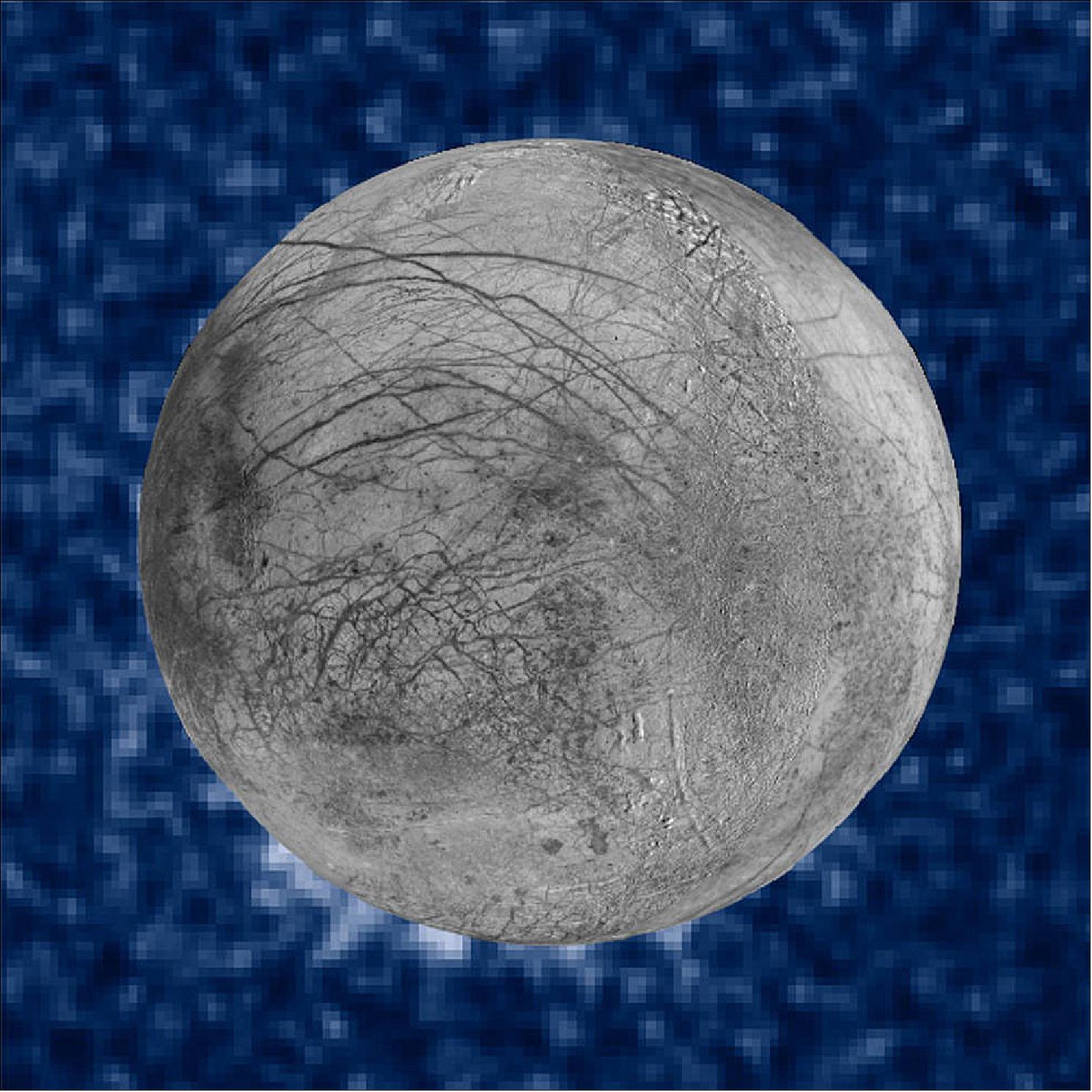
- The Europa Clipper team is set to succeed whether or not researchers find plumes at Europa, though many scientists hope for a spectacular water show to enrich the mission and our understanding of Europa. "I do suspect Europa is active and letting some material escape," Hedman said. "But I expect that when we actually get to understand how it's doing that, it's not going to be what anyone expected."
- Missions such as Europa Clipper contribute to the field of astrobiology, the interdisciplinary research on the variables and conditions of distant worlds that could harbor life as we know it. While Europa Clipper is not a life-detection mission, it will conduct detailed reconnaissance of Europa and investigate whether the icy moon, with its subsurface ocean, has the capability to support life. Understanding Europa's habitability will help scientists better understand how life developed on Earth and the potential for finding life beyond our planet.
- Managed by Caltech in Pasadena, California, JPL leads the development of the Europa Clipper mission in partnership with the Johns Hopkins Applied Physics Laboratory in Laurel, Maryland, for NASA's Science Mission Directorate in Washington. The Planetary Missions Program Office at NASA's Marshall Space Flight Center in Huntsville, Alabama, executes program management of the Europa Clipper mission.
• July 12, 2021: Jupiter's moon Europa and its global ocean may currently have conditions suitable for life. Scientists are studying processes on the icy surface as they prepare to explore. 12)
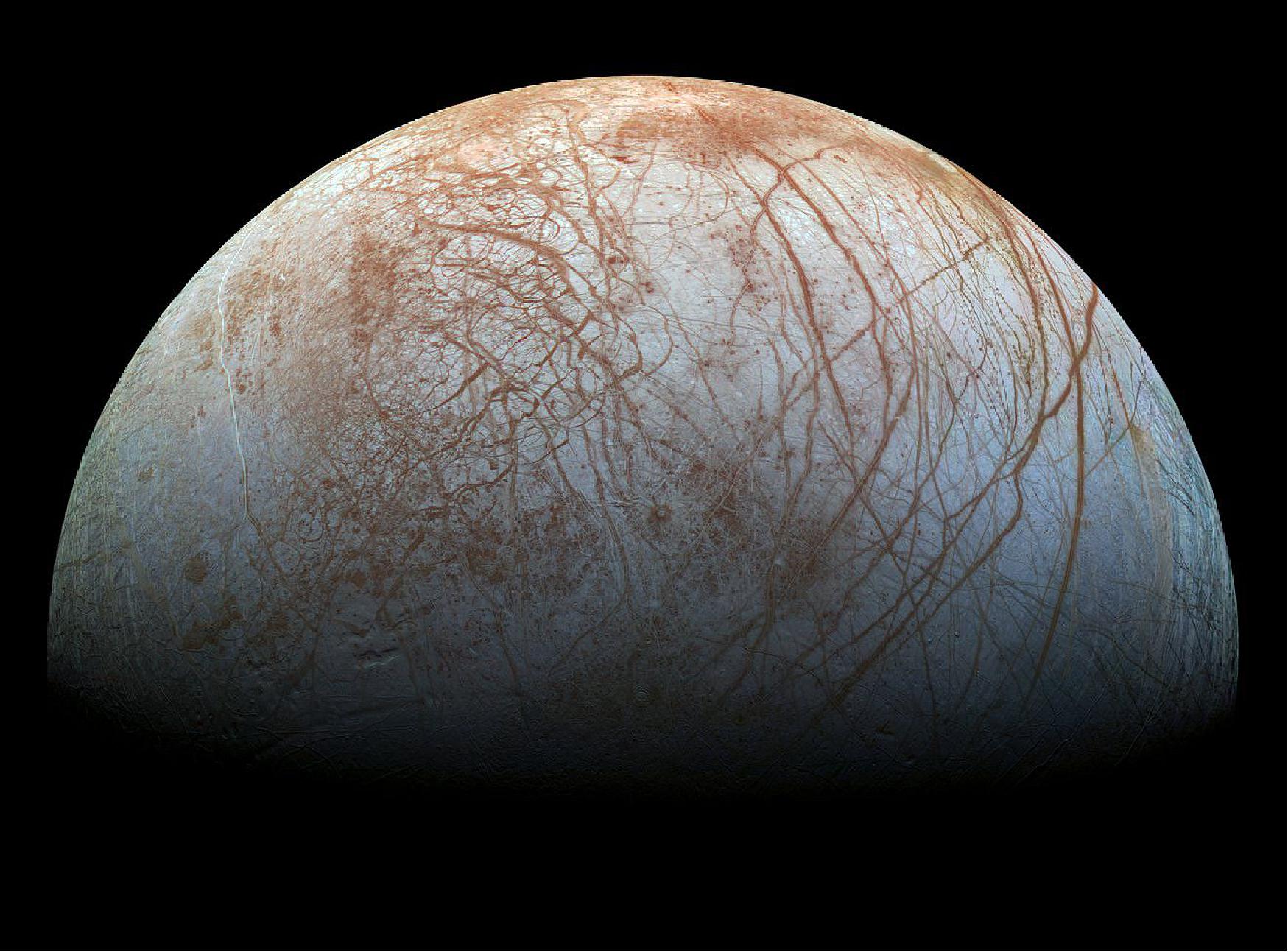
- It's easy to see the impact of space debris on our Moon, where the ancient, battered surface is covered with craters and scars. Jupiter's icy moon Europa withstands a similar trouncing – along with a punch of super-intense radiation. As the uppermost surface of the icy moon churns, material brought to the surface is zapped by high-energy electron radiation accelerated by Jupiter.
- NASA-funded scientists are studying the cumulative effects of small impacts on Europa's surface as they prepare to explore the distant moon with the Europa Clipper mission and study the possibilities for a future lander mission. Europa is of particular scientific interest because its salty ocean, which lies beneath a thick layer of ice, may currently have conditions suitable for existing life. That water may even make its way into the icy crust and onto the moon's surface.
- New research and modeling estimate how far down that surface is disturbed by the process called "impact gardening." The work, published July 12 in Nature Astronomy, estimates that the surface of Europa has been churned by small impacts to an average depth of about 12 inches (30 centimeters) over tens of millions of years. And any molecules that might qualify as potential biosignatures, which include chemical signs of life, could be affected at that depth. 13)
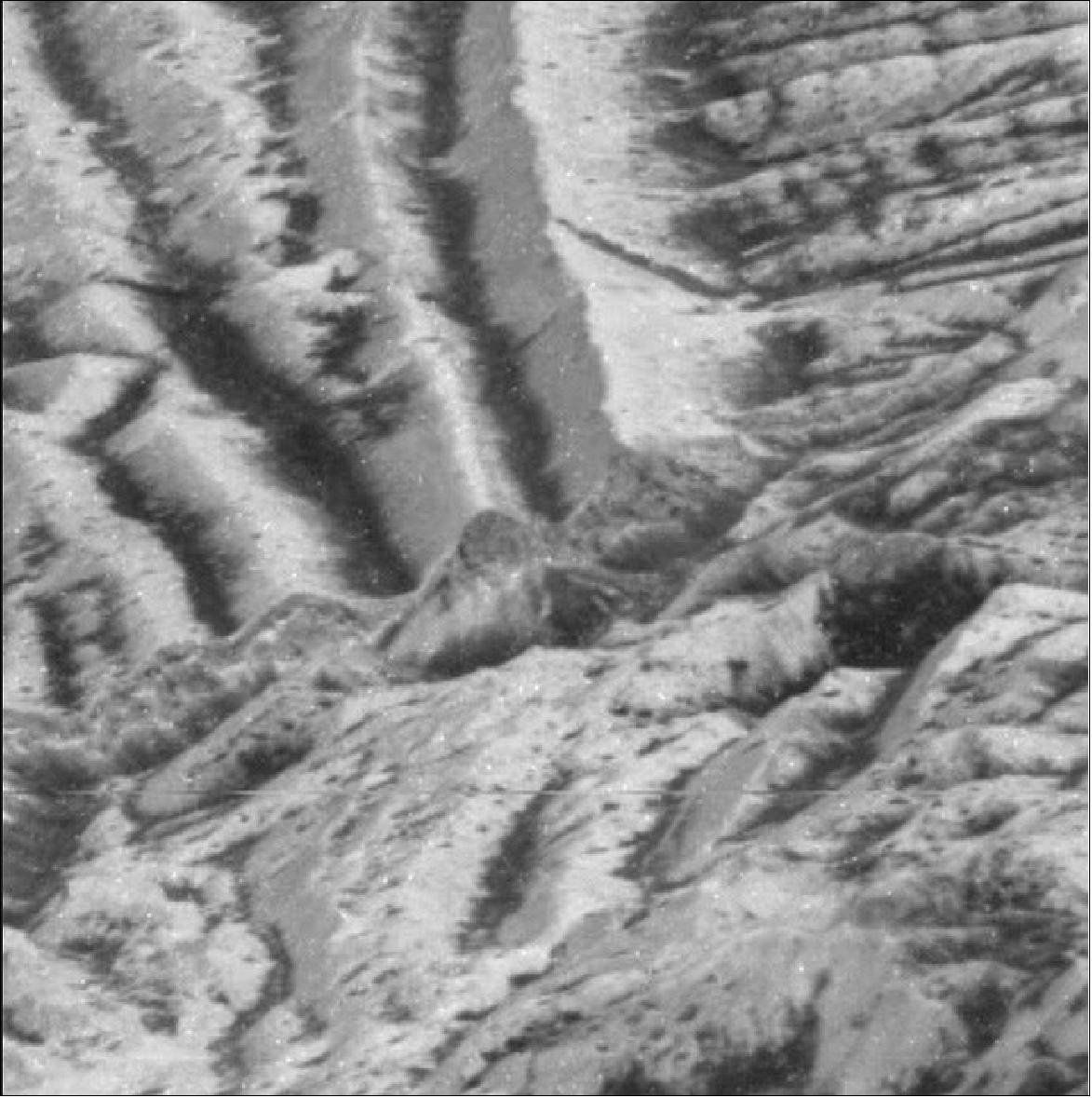
- That's because the impacts would churn some material to the surface, where radiation would likely break the bonds of any potential large, delicate molecules generated by biology. Meanwhile, some material on the surface would be pushed downward, where it could mix with the subsurface.
- "If we hope to find pristine, chemical biosignatures, we will have to look below the zone where impacts have been gardening," said lead author Emily Costello, a planetary research scientist at the University of Hawaii at Manoa. "Chemical biosignatures in areas shallower than that zone may have been exposed to destructive radiation."
Going Deeper
- While impact gardening has long been understood to be likely taking place on Europa and other airless bodies in the solar system, the new modeling provides the most comprehensive picture yet of the process. In fact, it is the first to take into account secondary impacts caused by debris raining back down onto Europa's surface after being kicked up by an initial impact. The research makes the case that Europa's mid- to high-latitudes would be less affected by the double whammy of impact gardening and radiation.
- "This work broadens our understanding of the fundamental processes on surfaces across the solar system," said Cynthia Phillips, a Europa scientist at NASA's Jet Propulsion Laboratory in Southern California and a co-author of the study. "If we want to understand the physical characteristics and how planets in general evolve, we need to understand the role impact gardening has in reshaping them."
- Managed by JPL for NASA, Europa Clipper will help develop that understanding. The spacecraft, targeting a 2024 launch, will conduct a series of close flybys of Europa as it orbits Jupiter. It will carry instruments to thoroughly survey the moon, as well as sample the dust and gases that are kicked up above the surface.
• May 25, 2021: Jupiter's moon Europa has an icy crust covering a vast, global ocean. The rocky layer underneath may be hot enough to melt, leading to undersea volcanoes. 14)
- New research and computer modeling show that volcanic activity may have occurred on the seafloor of Jupiter's moon Europa in the recent past – and may still be happening. NASA's upcoming Europa Clipper mission, targeting a 2024 launch, will swoop close to the icy moon and collect measurements that may shed light on the recent findings.
- Scientists have strong evidence that Europa harbors an enormous ocean between its icy crust and rocky interior. The new work shows how the moon may have enough internal heat to partially melt this rocky layer, a process that could feed volcanoes on the ocean floor. The recent 3D modeling of how this internal heat is produced and transferred is the most detailed and thorough examination yet of the effect this interior heating has on the moon.
- The key to Europa's rocky mantle being hot enough to melt lies with the massive gravitational pull Jupiter has on its moons. As Europa revolves around the gas giant, the icy moon's interior flexes. The flexing forces energy into the moon's interior, which then seeps out as heat (think of how repeatedly bending a paperclip generates heat). The more the moon's interior flexes, the more heat is generated.
- The research, published recently in Geophysical Research Letters, models in detail how Europa's rocky part may flex and heat under the pull of Jupiter's gravity. It shows where heat dissipates and how it melts that rocky mantle, increasing the likelihood of volcanoes on the seafloor.
- Volcanic activity on Europa has been a topic of speculation for decades. By comparison, Jupiter's moon Io is obviously volcanic. Hundreds of volcanoes there erupt lava fountains and eject volcanic gas and dust up to 250 miles (400 km) high – activity that is due to the same kind of internal heating caused by Jupiter's pull. But Europa is farther away than Io is from its host planet, so scientists have wondered whether the effect would be similar under the icy surface.
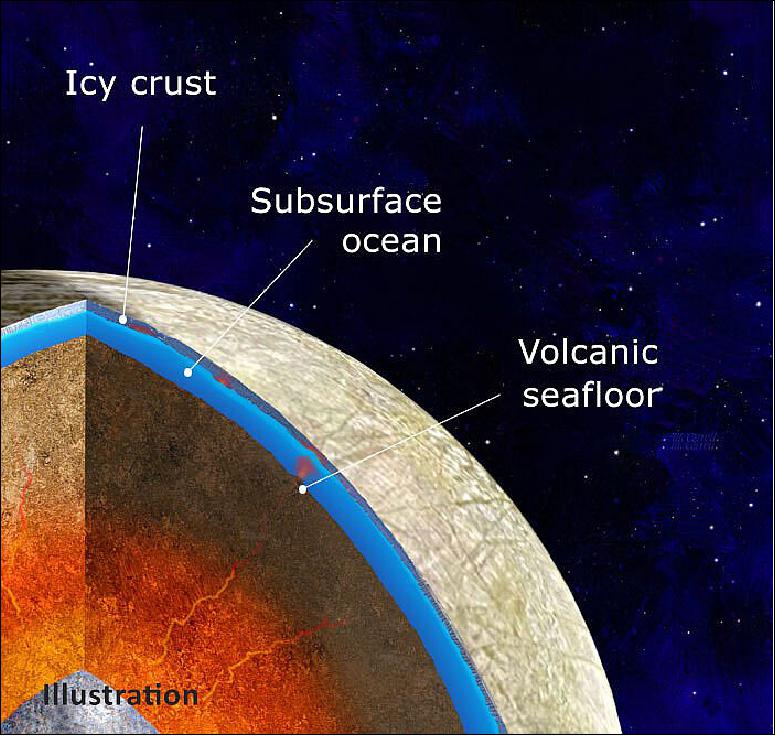
- Led by Marie Běhounková of Charles University in the Czech Republic, the authors further predicted that volcanic activity is most likely to occur near Europa's poles – the latitudes where the most heat is generated. They also looked at how volcanic activity may have evolved over time. Long-lived energy sources give more opportunity for potential life to have developed.
- Underwater volcanoes, if present, could power hydrothermal systems like those that fuel life at the bottom of Earth's oceans. On Earth, when seawater comes into contact with hot magma, the interaction results in chemical energy. And it is chemical energy from these hydrothermal systems, rather than from sunlight, that helps support life deep in our own oceans. Volcanic activity on Europa's seafloor would be one way to support a potential habitable environment in that moon's ocean.
- "Our findings provide additional evidence that Europa's subsurface ocean may be an environment suitable for the emergence of life," Běhounková said. "Europa is one of the rare planetary bodies that might have maintained volcanic activity over billions of years, and possibly the only one beyond Earth that has large water reservoirs and a long-lived source of energy."
Direct Observations
- NASA scientists will have the opportunity to put the new predictions to the test when Europa Clipper reaches its target in 2030. The spacecraft will orbit Jupiter and perform dozens of close flybys of Europa to map the moon and investigate its composition. Among the science data it collects, the spacecraft will survey the surface in detail and sample the moon's thin atmosphere.
- The surface and atmosphere observations will give scientists a chance to learn more about the moon's interior ocean if the water percolates up through the icy crust. Scientists believe the exchange of material between the ocean and the crust would leave traces of seawater on the surface. They also believe the exchange may emit gas, and possibly even plumes of water vapor, with ejected particles that could contain materials coming from the seafloor.
- As Europa Clipper measures the moon's gravity and magnetic field, anomalies in those areas, especially toward the poles, could help confirm the volcanic activity predicted by the new research.
- "The prospect for a hot, rocky interior and volcanoes on Europa's seafloor increases the chance that Europa's ocean could be a habitable environment," said Europa Clipper Project Scientist Robert Pappalardo of NASA's Jet Propulsion Laboratory in Southern California. "We may be able to test this with Europa Clipper's planned gravity and compositional measurements, which is an exciting prospect."
More About the Mission
- Missions such as Europa Clipper help contribute to the field of astrobiology, the interdisciplinary research on the variables and conditions of distant worlds that could harbor life as we know it. While Europa Clipper is not a life-detection mission, it will conduct detailed reconnaissance of Europa and investigate whether the icy moon, with its subsurface ocean, has the capability to support life. Understanding Europa's habitability will help scientists better understand how life developed on Earth and the potential for finding life beyond our planet.
- Managed by Caltech in Pasadena, California, JPL leads the development of the Europa Clipper mission in partnership with the Johns Hopkins Applied Physics Lab (APL) in Maryland for the agency's Science Mission Directorate in Washington. The Planetary Missions Program Office at NASA's Marshall Space Flight Center in Huntsville, Alabama, executes program management of the Europa Clipper mission.
• February 10, 2021: NASA is no longer considering launching the Europa Clipper mission on the Space Launch System, deciding instead to launch the spacecraft on a commercial rocket it will procure in the next year. 15)
• January 29, 2021: NASA has issued a request for information for launch services for its Europa Clipper mission, a sign the agency is taking advantage of language in a recent appropriations bill that allows it to consider alternatives to the Space Launch System. 16)
- The Jan. 26 request for information seeks data from companies that believe they have vehicles that can launch the mission, which will go into orbit around Jupiter and make dozens of close approaches to Europa, an icy, potentially habitable moon.
- The launch vehicle would have to be able to launch the spacecraft, weighing at least 6,065 kilograms, on a trajectory that would incorporate gravity-assist flybys of Mars and Earth before arriving at Jupiter. The launch would take place during a three-week window in October 2024.
- At a July 2020 briefing to a National Academies committee, Europa Clipper project officials presented a proposal for once such trajectory. A launch in October 2024 would be followed by flybys of Mars in February 2025 and of Earth in December 2026, with the spacecraft entering orbit around Jupiter in April 2030. NASA's Launch Services Program, the briefing stated, had determined that trajectory using a "commercial option" for a launch vehicle was feasible.
- The SLS had been the preferred vehicle for the Europa Clipper mission because it could get the spacecraft to Jupiter much more quickly. The same briefing described a launch window in August 2024 that, using SLS, would get the spacecraft to Jupiter in no more than three years, without the need for flybys.
- NASA, in recent budget proposals, sought to launch Europa Clipper on a commercial vehicle rather than SLS. It argued that doing so would save the agency as much as $1.5 billion and free up SLS vehicles for use in the Artemis program of human lunar exploration. Congress, though, mandated the use of SLS for Europa Clipper in appropriations bills through fiscal year 2020.
- Another factor in the launch vehicle debate emerged in August, when NASA disclosed it was investigating "potential hardware compatibility issues" between SLS and Europa Clipper. The agency didn't elaborate on the specific issues, believed to be associated with vibrations and other environmental factors the spacecraft would experience during launch.
- Congress, in the fiscal year 2021 omnibus spending bill passed last month, gave NASA some flexibility regarding the launch of Europa Clipper. The bill again directed the use of SLS for the mission, but only if "the SLS is available and if torsional loading analysis has confirmed Clipper's appropriateness for SLS." The latter condition refers to the hardware compatibility issues previously reported by NASA.
- The most likely commercial option for launching Europa Clipper is SpaceX's Falcon Heavy. United Launch Alliance's Delta 4 Heavy, an earlier option, is no longer available since the remaining vehicles have all been assigned to national security launches. ULA plans to retire the vehicle by the middle of the decade as it transitions to the Vulcan Centaur.
- Both Vulcan Centaur and Blue Origin's New Glenn could be alternatives, but neither vehicle has made its first flight. The request for information states that the vehicle for Europa Clipper must meet NASA's Category 3 requirements for launch services, which requires a vehicle have at least three successful launches, including at least two consecutive successful launches. Falcon Heavy has flown three times so far, all successfully.
- The appropriations bill that gave NASA the option to consider alternatives to SLS did direct the agency to conduct a "full and open competition" for launch services if it chose not to use SLS, including allowing vehicles that are not currently on its NASA Launch Services 2 contract.
- Responses to the request for information are due to NASA by Feb. 8. NASA hasn't stated when it will decide on how to launch Europa Clipper, or issue a formal request for proposals for launch services, but agency officials said last summer they had hoped to decide how they would launch the mission by the end of 2020.
Sensor Complement
Europa Clipper will carry science instruments more advanced and sensitive than anything that's explored this Jovian moon before. Through thoughtful collaboration, the mission's scientists will attempt to discover whether Europa hosts environments suitable for life. The spacecraft will not carry life-seeking instruments. Instead, we must first answer other questions, such as: 17)
• Does Europa really contain an ocean beneath its shell of ice?
• How deep is the ocean?
• Does the chemistry of the ocean seem friendly for microbes?
• Is Europa's ice shell active, allowing surface material to migrate to the ocean and vice versa, perhaps enriching the ocean with molecules from above that could serve as "food" for organisms?
Cameras
Europa Clipper's visible-light cameras (extending slightly into near-infrared and ultraviolet wavelengths) will map Europa at far better resolution than previous missions. The spacecraft's two infrared cameras will map the moon's surface composition, temperature, and roughness. Together, the cameras and other instruments will reveal much about Europa's chemistry and geologic activity.
EIS (Europa Imaging System)
A wide-angle camera and a narrow-angle camera, each with an eight-megapixel sensor, will produce high-resolution color and stereoscopic images of Europa. They will study geologic activity, measure surface elevations, and provide context for other instruments. PI: Elizabeth Turtle of JHU/APL. 18)
EIS will capture Europa's valleys, ridges, dark bands, and other features in profound detail. EIS has a wide-angle camera (WAC) and a narrow-angle camera (NAC). Each camera has an eight-megapixel sensor sensitive to visible wavelengths of light and a small range of near-infrared and ultraviolet wavelengths. The NAC pivots 60 degrees on two axes. Both cameras will produce stereoscopic images and have filters to acquire color images.
EIS will map about 90 percent of Europa at 330 feet (100 m) per pixel. That's six times more of Europa's surface at five times better resolution than the finest images from the Galileo spacecraft. When the spacecraft is close to Europa during flybys, EIS will produce images with a resolution 100 times better.
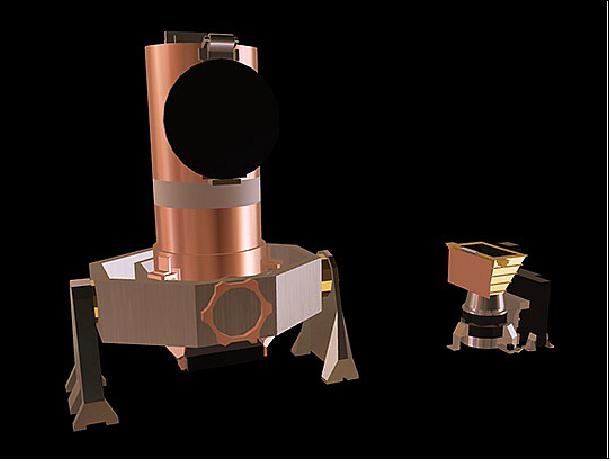
How it works: The WAC (Wide-Angle Camera) sees large portions of Europa's landscape. The NAC (Narrow-Angle Camera) has a more "zoomed-in" view and sees smaller portions of the landscape, but with more pixels per unit area than the WAC.
The NAC is a reflecting telescope and uses a large mirror to collect light. Then other mirrors and lenses direct a condensed beam onto an eight-megapixel detector called a complementary metal oxide semiconductor (commonly known as CMOS ). Cell phones and digital cameras also use CMOS detectors, which are perhaps the most widely-used NASA spinoff technology in the world. The WAC has the same kind of sensor, but is a refracting telescope instead of a reflecting telescope. It lets the light directly in and uses lenses to focus the light onto its detector.
How we'll use it: Scientists will use EIS to study surface features and how they relate to each other and to sub-surface structures. The instrument will search for signs of recent geologic activity on the moon's surface. It will also look for potential plumes venting material into space. EIS's three-dimensional views will allow scientists to measure surface heights. Color images will provide information about Europa's surface materials.
"We're not quite sure how some of the features on Europa's surface formed," said Lynnae Quick, a planetary scientist at NASA's Goddard Space Flight Center and a member of Europa Clipper's imaging team. "Really high-resolution images will give us clues as to how these features formed."
E-THEMIS (Europa Thermal Emission Imaging System)
The thermal imager uses infrared light to distinguish warmer regions on Europa where warm liquid water may be near the surface or might have erupted onto the surface. It will also measure surface texture to understand the small-scale properties of the surface. PI: Philip Christensen, ASU (Arizona State University). 19)
E-THEMIS will map Europa's temperatures. It will seek clues about activity such as cryovolcanos, and regions where the moon's suspected ocean may be near the surface.
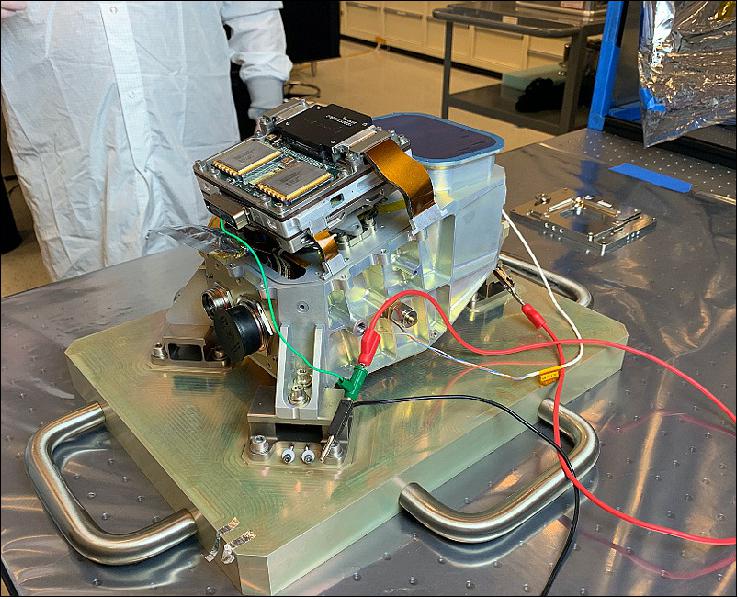
Spectrometry
Different atoms and molecules emit, absorb, and reflect various wavelengths of light in telltale ways. As such, light carries information about materials it has interacted with. Europa Clipper's spectrometer and spectrograph will dissect incoming infrared and ultraviolet light to decode that information and reveal the composition of Europa's surface, and of particles in space near Europa.
Europa-UVS (Europa UV Spectrograph)
By collecting ultraviolet light with a telescope, and creating images, the mission's ultraviolet spectrograph will help determine the composition of Europa's atmospheric gases and surface materials. It will also search near Europa for signs of plume activity. PI: Kurt Retherford, SwRI. 20)
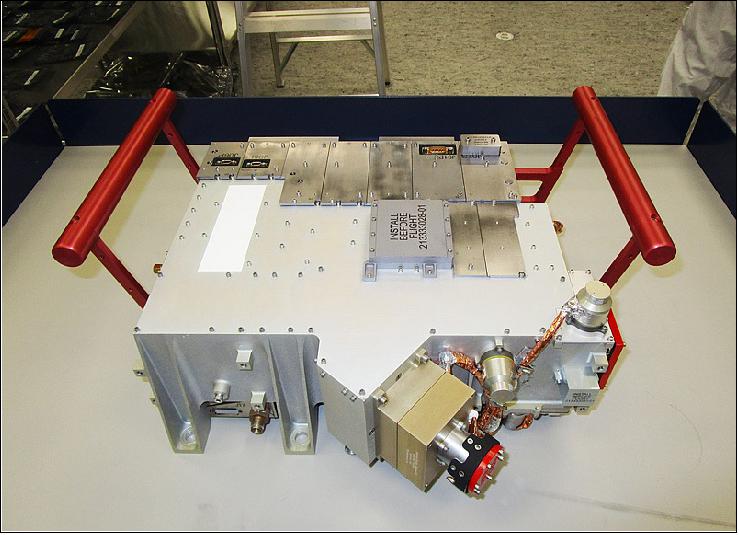
Mass | 19.6 kg |
Operating power | 8.5 W |
Size | 35.7 x 36.2 x 15.8 cm |
Spectral range | 55-210 nm |
Spectral resolution | <0.6 nm (point source), <1.2 nm (extended source); |
Spatial resolution | 0.16º (Airglow Port), 0.06º (High-spatial-resolution Port) |
FOV (Field Of View) | 0.1º x 7.3º + 0.2º x 0.2º (7.5º full length) |
Effective area | 0.6 cm2 @ 125 nm |
Telescope/Spectrograph | Off-axis primary/Rowland circle mount |
Detector type | 2D MCP (solar blind), Csl photocathode, cross-delay-line (XDL) readout, |
Spectral cube size | 1900 (spectral) x 1150 (spatial), maximum active area |
Radiation mitigation | Contiguous High-Z shielding (4π sr @detector and electronics) |
How it works: "Light enters a telescope and bounces off a mirror," said Kurt Retherford, a staff scientist at the Southwest Research Institute in San Antonio, TX, and principal investigator for Europa-UVS. "The instrument focuses the light through a slit. Then the light lands on a grating that disperses the light across a detector," he said. "It's like a digital image you take with a cell phone camera."
But unlike a cell phone, Europa-UVS sees ultraviolet light, and records more than pictures. Different elements emit and absorb specific wavelengths of light. The instrument records how bright the light is at each of those wavelengths. The resulting data contains the telltale signatures of atoms and molecules. It tells scientists exactly what material the light passed through, or reflected against.
How we'll use it: Europa-UVS will study the composition and structure of Europa's atmosphere and surface. It will search near Europa for vapor plumes venting into space from the moon's liquid water ocean or from reservoirs in its icy shell. Studying that material will be akin to dipping a test tube directly into those bodies of liquid. The instrument will also study the moon's aurora, its own sort of northern lights.
The instrument will primarily identify relatively simple molecules, such as hydrogen (H2), oxygen (O2), hydroxide (OH), and carbon dioxide (CO2). But Europa-UVS measurements also might be able to detect simple hydrocarbons such as methane (CH4) and ethane (C2H6). Those are building blocks for complex molecules like amino acids — the raw materials of life as we know it. The mission isn't directly seeking life on Europa, but instead will determine if the moon could support life. Organic molecules in a plume or on the surface would suggest that Europa may have the ingredients for some form of life.
MISE (Mapping Imaging Spectrometer for Europa)
The mission's infrared spectrometer will map the distribution of ices, salts, organics, and the warmest hotspots on Europa. The maps will help scientists understand the moon's geologic history and determine if Europa's suspected ocean is suitable for life. PI: Diana Blaney, NASA/JPL).
MISE will analyze infrared light reflected from Europa. It will measure the presence, absence, strength, and weakness of various wavelengths, or frequencies, of light. MISE will map Europa's surface composition in detail. 21)
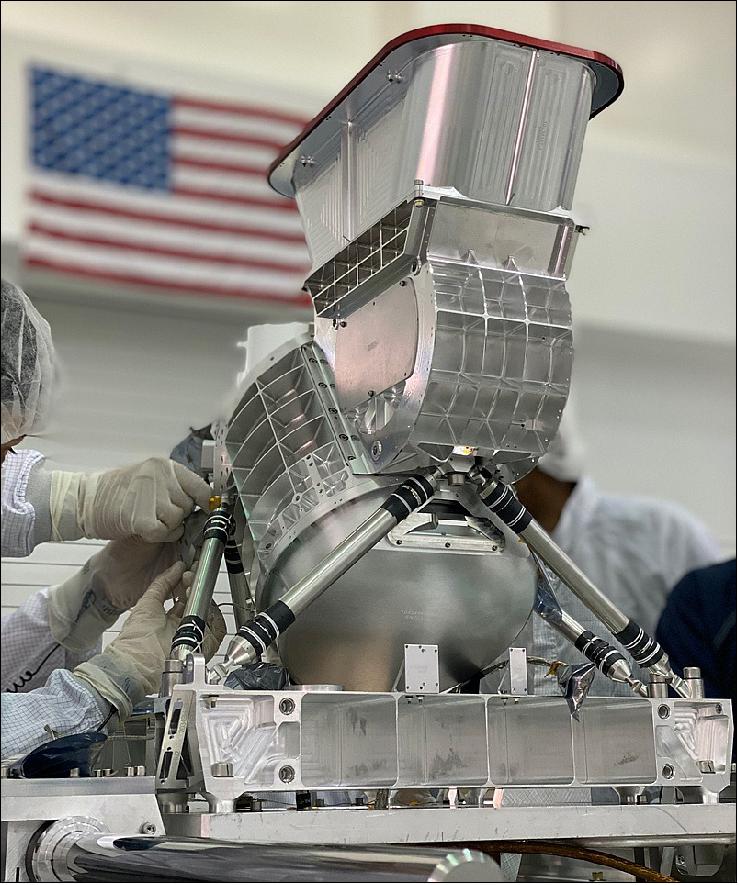
How it works: Infrared light enters MISE through a slit. Mirrors direct the light to a calcium fluoride (CaF2) lens, which directs the light to a grating. The grating cuts light into discrete wavelengths, which then strike a detector. But MISE doesn't produce a picture all at once like a conventional camera.
MISE team member and JPL systems engineer Rick Redick explains further. "With the slit, our observation is only a line, instead of a rectangle," Redick said. "That way it can measure multiple wavelengths of infrared light in each location." MISE then captures a second line adjacent to the first, and so on until it has 300 lines. The approach is called pushbroom observation. The 300 lines can be combined to make one picture containing the signatures of whatever atoms and molecules are present.
How we'll use it: "We're looking for salts such as sulfates, carbonates, and other compounds," said JPL scientist Diana Blaney, principal investigator for MISE. "And we're looking for organics, which could be coming from the ocean. They would help us understand if Europa is habitable." MISE will also detect Europa's warmest hotspots, which may indicate areas of recent or present plume activity. MISE maps will help scientists understand Europa's geologic history, and the moon's suspected ocean. They will also help scientists learn how material circulates between the ocean and Europa's surface.
Plasma and Magnetic Field
Jupiter's magnetic field, the largest in the solar system, traps the charged particle gas – plasma – that fills the space surrounding Europa (and the rest of the Jupiter system). As Europa moves in its orbit, the magnetic field varies. Time-variations of the magnetic field induce Europa to produce its own magnetic field that, in turn, will provide clues to the structure of the moon's interior.
ECM (Europa Clipper Magnetometer)
The magnetometer investigation aims to confirm that Europa's ocean exists, measure its depth and salinity, and measure the moon's ice shell thickness. It will also study Europa's ionized atmosphere and how it interacts with Jupiter's ionized atmosphere. Team leader: Margaret Kivelson, UCLA, University of Michigan). 22)
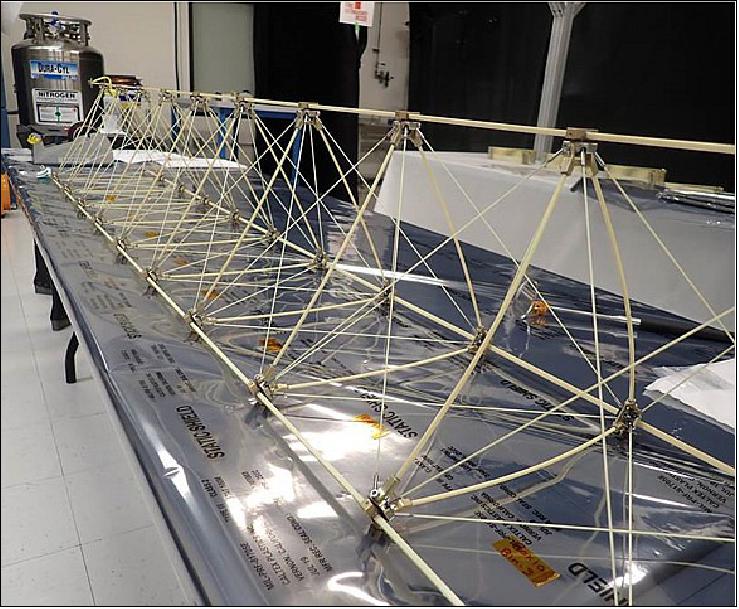
ECM will measure strength and orientation of magnetic fields during dozens of Europa flybys. Compasses and magnetometers can both detect magnetic fields. But scientific magnetometers are far more sensitive and precise. They allow scientists to accurately measure magnetic fields and study how they vary with time and location.
The magnetometer boom will be8.5 m long, with three flux-gate sensors. To fit aboard the rocket, the boom will be stowed in a canister. It will deploy to its full length in the days after launch. The magnetometer should allow scientists to confirm the existence of Europa's ocean, and measure its depth and salinity. The instrument will also measure the ice shell's thickness.
How it works: Jupiter rotates once every 10 hours and its magnetic field spins right along with it. The magnetic field whips high-energy plasma along at almost the same rate. The plasma distorts the magnetic field near Europa, as does the spacecraft itself, and this affects magnetometer data.
But other science instruments will study plasma around Europa and learn how it affects the magnetic field. Engineers have modeled how the spacecraft will distort the magnetic field. The magnetometer team will remove those factors from their data to get a clearer and more accurate picture of Europa's magnetic field. "What we want to extract is the field generated in Europa. That's what we're after," said Margaret Kivelson, magnetometer team leader and a space physicist at UCLA and the University of Michigan.
How we'll use it: Europa doesn't independently generate its own magnetic field. But time-variations of Jupiter's magnetic field induce Europa to produce one, probably via electric currents flowing in a salty ocean beneath Europa's ice. The magnetometer should allow scientists to confirm the ocean's existence, and measure its depth and salinity as well as the ice shell's thickness.
If Europa has an ocean, the thickness of the moon's ice shell is critical to the ocean's possible habitability. High-energy radiation alters Europa's surface compounds. Thinner ice improves the odds that those surface compounds travel through the ice to the ocean. It would also enable ocean material to reach the surface more easily to be altered by Jupiter radiation before again migrating back to the ocean.
PIMS (Plasma Instrument for Magnetic Sounding)
Europa's ionosphere, and plasma trapped in Jupiter's magnetic field, distort magnetic fields near Europa. PIMS Faraday cups will distinguish those distortions from Europa's induced magnetic field, which carries information about Europa's ocean. PI: Joseph Westlake, JHU/APL).
Built by the Johns Hopkins Applied Physics Laboratory (APL) in Laurel, Maryland, PIMS is made up of two instruments, each with two identical sensors called Faraday cups that will measure the plasmas, or electrically charged gases, in Europa's ionosphere and Jupiter's magnetosphere. Pictured in a clean room at APL are the recently assembled Faraday cup sensors and instrument housings in two configurations. On the left is the final flight hardware, with insulating thermal blankets installed; on the right is a test configuration that protects sensitive hardware for transportation. Plasma measurements made by PIMS will contribute to Europa Clipper's science investigation to determine the thickness of the ice shell that covers Europa and the depth and makeup of the liquid-water ocean below that shell. 23)
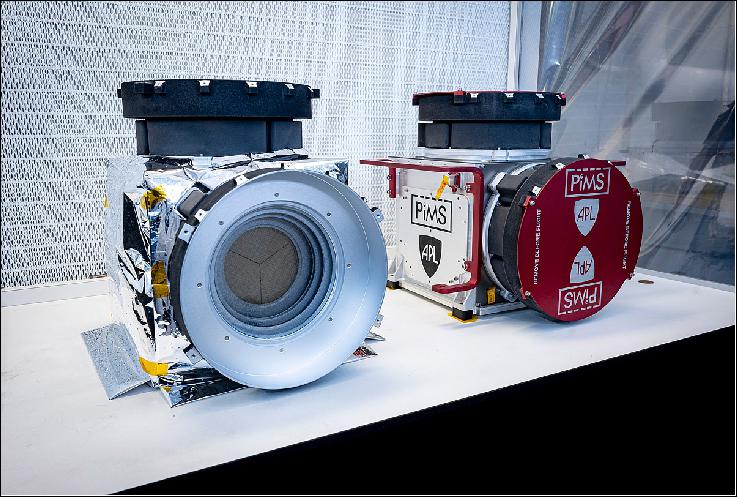
Jupiter's magnetic field induces a magnetic field at Europa. The mission's magnetometer investigation will study the moon's magnetic field. The goal is to reveal Europa's ocean depth and conductivity, and ice shell thickness.
Jupiter's magnetic field also carries charged particles called plasma from the volcanic moon Io, Jupiter's ionosphere, and Europa itself. The plasma distorts Europa's induced magnetic field and distorts the magnetic signal. The Plasma Instrument for Magnetic Sounding, or PIMS, will study the density, temperature and flow of plasma near Europa. PIMS will help correct the magnetic induction signal for plasma distortions around Europa. It's the key to precisely determining Europa's ice shell thickness, ocean depth, and conductivity.
How it works: PIMS has four sensors called Faraday cups to study plasma's density, temperature, and velocity. Each cup is about three inches (eight centimeters) deep and eight inches (20 cm) wide. A grid near the top of each cup produces an electric field to block unwanted particles. In the bottom of each cup is a flat, circular detector plate with three 120º segments, like a pie with three equal slices. Plasma creates an electrical current when it strikes the plate, revealing the plasma's speed and density.
If plasma enters the Faraday cup head-on, it strikes the center of the plate and generates equal currents on all three segments. When plasma enters the cup at an angle, it strikes one segment more than the other two. That tells the instrument what direction the plasma was coming from.
How we'll use it: Jupiter rotates once every 10 hours, carrying with it a donut-shaped ring of plasma (ions and electrons). "It's like a river of particles flowing at 100 km/s," said Joseph Westlake, principal investigator for PIMS and chief scientist for space physics at the Johns Hopkins University Applied Physics Laboratory. That's more than 200,000 miles per hour, or about 100 times the speed of a bullet.
"Plasma distorts magnetic fields around Europa and obscures the induction signal from the magnetometer," said Corey Cochrane, a JPL engineer and scientist on the ECM and PIMS teams. "PIMS will allow us to model the plasma and subtract its contribution from magnetometer data." It will let scientists study Europa's ocean depth and conductivity, and ice shell thickness.
Radar & Gravity
Europa's physical properties affect radio signals, which will help reveal the moon's interior. A gravity experiment will analyze frequency shifts in the spacecraft's signals to Earth (the same signals used in communication and navigation) to study Europa's internal structure. A radar instrument will transmit radio into Europa's icy shell and analyze the bounced signals to "see" internal features.
Gravity/Radio Science
Europa and its gravity field flex as the moon's non-circular orbit carries it closer, then farther, from Jupiter. Measuring Europa's gravity at various points in the moon's orbit will show how Europa flexes and help reveal its internal structure. Team Leader: Erwan Mazarico,NASA/GSFC). 24)
Gravity pulls on Europa's Jupiter-facing side more than on its far side. Europa's orbit is elliptical, causing the moon's distance from Jupiter to vary. Because gravity's strength is an inverse-square of distance, the closer Europa gets to Jupiter, the greater the difference in gravity felt by the moon's near and far sides. As a result, Europa elongates when closer to Jupiter, and is more spherical when farther from Jupiter. When Europa changes shape, so must its gravity field.
Europa Clipper will pass through Europa's gravity field when the moon is various distances from Jupiter. By studying how the spacecraft's trajectory is altered by Europa's gravity during each flyby, scientists will learn how the moon flexes, which in turn will reveal Europa's internal structure.
How it works: In gravity experiments, radio antennas on Earth send a radio signal to Europa Clipper. The spacecraft then transmits to Earth at a frequency coherent to what it received. The gravity science team precisely analyzes the Doppler shift and other aspects of the radio signal received on Earth. Then they trace it back a few steps.
"It's like when a firetruck goes by and the pitch of the siren changes," said Dustin Buccino, a JPL scientist and engineer, and co-investigator for the gravity investigation. "We measure the difference between the frequency the spacecraft sent and the frequency Earth received. It gives us details about the spacecraft's motion, which gives us details about Europa's gravity field."
How we'll use it: Europa Clipper will pass through Europa's gravity field 45 times when the moon is various distances from Jupiter. The shape of Europa's gravity field mirrors the shape of the moon itself. By studying how Europa's gravity field changes shape, scientists are actually measuring how the moon itself changes shape.
"We're trying to figure out Europa's tidal Love number," Buccino said. The number represents how susceptible a world is to tidal forces, which depends on each world's internal structure. "We want to find out how deep the ocean is," Puccini said. "That's what the tidal Love number leads to." Europa's flexing is determined by how much water the moon contains, how close water is to the surface, and other factors. That tells scientists the moon's ice thickness.
REASON (Radar for Europa Assessment and Sounding: Ocean to Near-Surface)
Ice-penetrating radar will probe Europa's icy shell for the moon's suspected ocean and study the ice's structure and thickness. It will also study the moon's surface elevations, composition, and roughness, and search the moon's atmosphere for plumes. PI: Donald Blankenship, University of Texas, Austin. 25)
Europa Clipper will carry nine instruments with overlapping abilities and responsibilities. But only one can look directly into Europa's icy shell. It's called the Radar for Europa Assessment and Sounding: Ocean to Near-surface, or REASON.
Radar is a powerful and versatile science tool. It uses radio waves to detect objects from afar. An array of antennas transmits signals, which bounce off objects and return to the array with a time delay. A given radio wavelength will pass through certain kinds of matter but be reflected by other kinds of matter. When you know what matter you want to detect (water or salt, for example) and what you want to pass through (ice), you choose radio wavelengths or frequencies that pass through one but bounce off the other before the signal loses strength.
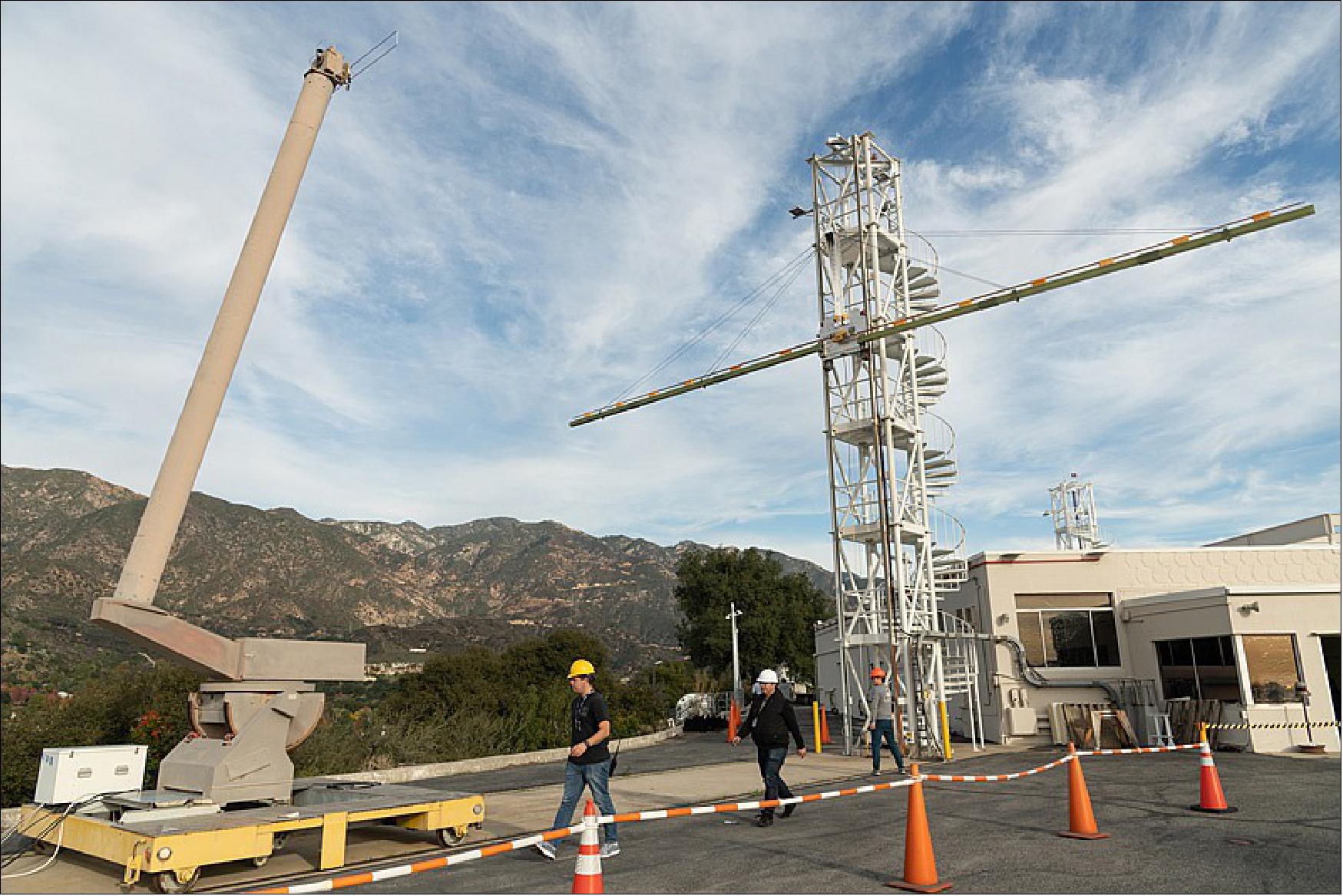
How it works: REASON transmits radio waves that bounce off features within the underlying ice. Some radio waves return to the spacecraft, but at a fraction of their original energy. By measuring the time difference between transmission and return, and knowing the speed radio waves travel through various materials, REASON learns how far the features are from the spacecraft.
By measuring the energy difference between transmitted signal and returning signal, combined with the measured distance, REASON can see differences in material properties. Scientists on Earth then use software to combine the radio waves to produce detailed images of the ice shell.
How we'll use it: Different wavelengths of radio waves penetrate and bounce off different materials in distinct ways. REASON will use high frequency and very high frequency radio waves to penetrate Europa's ice as much as 18 miles (30 km) deep. It will search for the moon's suspected ocean, measure ice thickness, and study the ice's internal structure, including any internal water bodies that may connect the surface and the ocean. The instrument will also study the topography, composition, and roughness of Europa's surface. And it can search Europa's ionosphere for signs of plume activity.
Chemical Analysis
Radar and cameras "look" at things from afar, while other science instruments such as magnetometers sense the environment immediately around the spacecraft. Still others collect gas and dust in space to identify their chemical makeup. Europa Clipper's complementary dust spectrometer and neutral gas mass spectrometer perform such collections; they are the mission's "hands-on" experiments.
MASPEX (MAss SPectrometer for Planetary EXploration/Europa)
The mass spectrometer will analyze gases in Europa's faint atmosphere and possible plumes. It will study the chemistry of the moon's suspected subsurface ocean, how ocean and surface exchange material, and how radiation alters compounds on the moon's surface. PI: James Burch, SwRI. 26)
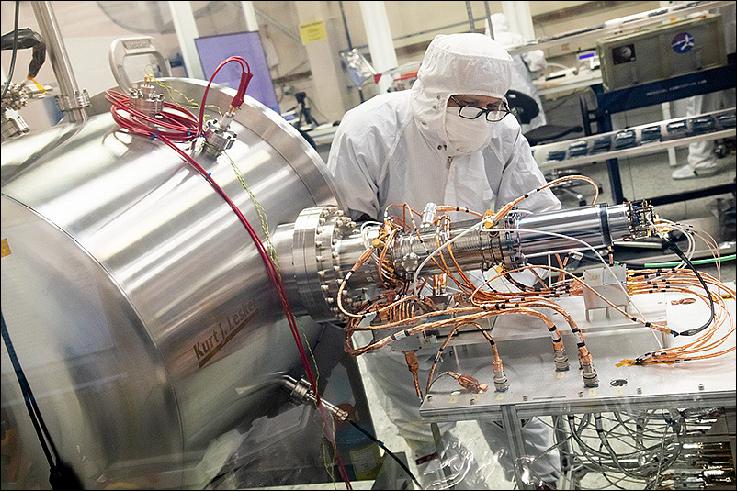
The space near Europa teems with gases. Some get knocked off Europa's surface by Jupiter's relentless radiation. Others might vent into space from Europa's suspected subsurface ocean, or from water trapped in the moon's ice shell. The MASPEX/Europa will identify those molecules with unparalleled precision.
MASPEX collects gases and converts them into charged particles called ions. It bounces the ions (atoms and molecules missing an electron) back and forth within the instrument. By timing their transit through the instrument, MASPEX determines the ions' mass. The mass reveals each molecule's identity to help determine whether Europa is habitable.
How it works: MASPEX generates high-energy (fast moving) electrons to strip electrons from incoming gas molecules. That makes the gas molecules into positively-charged ions. The instrument accelerates the ions to a uniform amount of energy. The ionized gases are pulled into the "drift tube," which gives MASPEX its baguette-like length. The lighter the ion, the faster it can move through the drift tube.
MASPEX bounces the ions back and forth several times in the drift tube before the instrument detects them. The total distance they travel increases their difference in arrival time, magnifying their mass difference. It's like two siblings in a footrace. Racing across their backyard they might finish at almost the same time. But if they run around the block, their difference in speed is easier to observe.
How we'll use it: MASPEX will gain crucial answers from gases near Europa, such as the chemistry of Europa's surface, atmosphere, and suspected ocean. MASPEX will study how Jupiter's radiation alters Europa's surface compounds and how the surface and ocean exchange material.
"MASPEX has a mass resolution hundreds of times finer than anything that's flown to space before," said MASPEX principal investigator James Burch, a planetary scientist and experimental space physicist at the Southwest Research Institute.
Carbon monoxide and molecular nitrogen have nearly equal atomic mass. But the energy binding their atoms alters their mass in telltale ways. MASPEX uses that mass deficit to identify molecules. It also differentiates isotopes – atoms with equal numbers of protons but a different number of neutrons.
Life might be able to survive in the moon's subsurface ocean, or in liquid water reservoirs in Europa's ice. If an ocean or reservoir is erupting into space, MASPEX can analyze its chemistry. "Plumes or gas leakage are the most exciting possibility," said Christopher Glein, MASPEX co-investigator and a planetary geochemist at the Southwest Research Institute. "We know microbes on Earth exploit any molecule that can serve as a food source. Mass spectrometers are great at sniffing out those molecules.
"We can believe Europa has plumes venting into space, or the right stuff for life," Glein said. "But it's like what Carl Sagan advocated: 'I don't want to believe. I want to know.' Knowing is the goal, and Europa Clipper will be our truth teller," he said.
SUDA (SUrface Dust Analyzer)
Tiny meteorites eject bits of Europa's surface into space, and a subsurface ocean or reservoirs might vent material into space as plumes. The dust analyzer will identify that material's chemistry and area of origin, and offer clues to Europa's ocean salinity. PI: Sascha Kempf, University of Colorado Boulder, Laboratory for Atmospheric and Space Physics (LASP). 27)
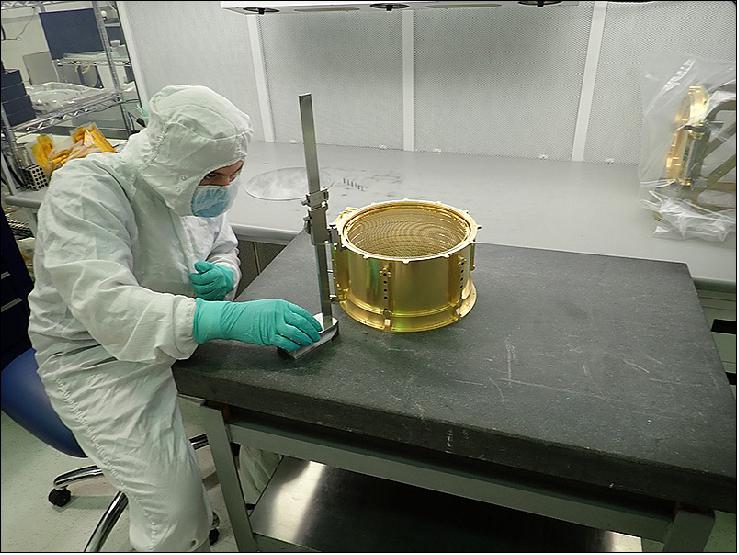
Micrometeorites constantly blast fragments of Europa's surface into space. The ejecta are individually small, but scientists estimate that half a ton (500 kg) of Europa's surface material floats above the moon at all times.
Europa Clipper's SUDA will scoop up the ejecta and identify its chemistry, revealing Europa's surface composition including potential organic molecules. SUDA is uniquely capable of detecting salts in the dust/ice grains. The grains' speed and direction will tell SUDA their origin on Europa's surface. If a subsurface ocean or reservoir is venting material into space as plumes (like the geyser Old Faithful), SUDA will analyze it to help determine if Europa's water is suitable for some form of life.
How it works: When dust enters SUDA, it passes through a series of metal mesh grids that measure the dust's speed and trajectory, which identify the dust's area of origin on Europa's surface.
The dust then strikes a metal target plate. "It splatters dust grains into individual molecules and ionizes some of them," said SUDA investigation scientist Murthy Gudipati, a planetary scientist and astrophysicist. Once ionized (electrically charged), the molecules must obey SUDA's electrical field, which funnels them to a detector. An ion's mass-to-charge ratio determines how long it takes to reach the detector. The timing reveals the molecule's mass and composition. "We can resolve amino acids, sulfates, whatever," Gutipati said. "We can identify whether organic molecules are abiotic or biomolecules."
How we'll use it: A dust grain's trajectory helps scientists know where on Europa's surface it came from. Knowing the grain's speed helps pin down the dust's origin even more accurately.
Each dust particle's chemistry is a data point indicating the composition of one spot on Europa's surface.
SUDA will study how much Europa surface material originated from elsewhere, said Sascha Kempf, SUDA's principal investigator and a planetary scientist at University of Colorado-Boulder. "When using Europa's surface material to draw conclusions about the moon's interior, you first need to know how much surface material is not from Europa," he said. "All the Galilean moons are exchanging material all the time, just as Earth, Mars, and the Moon do."
"We are not a life-finding mission," Gudipati said. "Europa Clipper's goal is to understand Europa's ocean and the moon's habitability. My hope is that SUDA provides compositional information to improve our understanding of that ocean."
The Galileo mission performed some Europa flybys, blazing the trail for Europa Clipper, Kempf said. "Observations from Galileo flybys matched very nicely the model predictions, so we really have a solid understanding of how much dust is there and how much we'll detect," he said. "Galileo's team did the work that allowed us to plan and design an instrument optimized for the environment around Europa. We didn't have to design a Swiss army knife of an instrument. The instrument is tailored specifically to what we know is there and what we want to learn."
References
1) "Europa Clipper's Mission to Jupiter's Icy Moon Confirmed," NASA, 19 August 2019, URL: https://www.nasa.gov/feature/europa-clippers-mission-to-jupiter-s-icy-moon-confirmed
2) NASA Scientists Confirm Water Vapor on Europa," NASA, 18 November 2019, URL: https://www.nasa.gov/feature/goddard/2019/nasa-scientists-confirm-water-vapor-on-europa
3) "NASA Awards Launch Services Contract for Europa Clipper Mission," NASA News Release 21-098, 23 July 2021, URL: https://www.nasa.gov/press-release/nasa-awards-launch-services-contract-for-europa-clipper-mission
4) "A Few Steps Closer to Europa: Spacecraft Hardware Makes Headway," NASA/JPL, 5 August 2021, URL: https://www.jpl.nasa.gov/news/a-few-steps-closer-to-europa-spacecraft-hardware-makes-headway?utm_source=iContact&utm_medium=email&utm_campaign=nasajpl&utm_content=europa20210805-1
5) "Meet Europa Clipper," NASA, URL: https://europa.nasa.gov/spacecraft/meet-europa-clipper/
6) "NASA's Europa Clipper Mission Completes Main Body of the Spacecraft," NASA/JPL, 7 June 2022, URL: https://www.jpl.nasa.gov/news/nasas-europa-clipper-mission-completes-main-body-of-the-spacecraft?utm_source=iContact&utm_medium=email&utm_campaign=nasajpl&utm_content=europaclipper20220607
7) "Greenland Ice, Jupiter Moon Share Similar Feature," NASA/JPL News, 25 April 2022, URL: https://www.jpl.nasa.gov/news/greenland-ice-jupiter-moon-share-similar-feature?utm_source=iContact&utm_medium=email&utm_campaign=nasajpl&utm_content=europa20220425
8) Riley Culberg, Dustin M. Schroeder & Gregor Steinbrügge, "Double ridge formation over shallow water sills on Jupiter's moon Europa," Nature Communications, Volume 13, Article number: 2007, Published: 19 April 2022, https://doi.org/10.1038/s41467-022-29458-3, URL: https://www.nature.com/articles/s41467-022-29458-3.pdf
9) "NASA Begins Assembly of Europa Clipper Spacecraft," NASA/JPL News, 3 March 2022, URL: https://www.jpl.nasa.gov/news/nasa-begins-assembly-of-europa-clipper-spacecraft?utm_source=iContact&utm_medium=email&utm_campaign=nasajpl&utm_content=europa20220303-1
10) "ASU instrument captures breathtaking 'first light' images," ASU, 10 January 2022, URL: https://news.asu.edu/20220110-discoveries-asu-instrument-captures-breathtaking-first-light-images
11) Lonnie Shekhtman"Are Water Plumes Spraying from Europa? NASA's Europa Clipper is on the Case," NASA Feature, 30 November 2021, URL: https://www.nasa.gov/feature/goddard/2021/are-water-plumes-spraying-from-europa-nasa-s-europa-clipper-is-on-the-case
12) "Surface of Jupiter's Moon Europa Churned by Small Impacts," NASA/JPL News Release 2021-141, 12 July 2021, URL: https://www.jpl.nasa.gov/news/surface-of-jupiters-moon-europa-churned-by-small-impacts?utm_source=iContact&utm_medium=email&utm_campaign=nasajpl&utm_content=europa20210712-1
13) E. S. Costello, C. B. Phillips, P. G. Lucey & R. R. Ghent, "Impact gardening on Europa and repercussions for possible biosignatures," Nature Astronomy, Published: 12 July 2021, https://doi.org/10.1038/s41550-021-01393-1
14) "Europa's Interior May Be Hot Enough to Fuel Seafloor Volcanoes," NASA/JPL News, 25 May 2021, URL: https://www.jpl.nasa.gov/news/europas-interior-may-be-hot-enough-to-fuel-seafloor-volcanoes?utm_source=iContact&utm_medium=email&utm_campaign=nasajpl&utm_content=europa0210525-1
15) Jeff Foust, "NASA to use commercial launch vehicle for Europa Clipper," SpaceNews, 10 February 2021, URL: https://spacenews.com/nasa-to-use-commercial-launch-vehicle-for-europa-clipper/
16) Jeff Foust, "NASA seeks input on Europa Clipper launch options," SpaceNews, 29 January, 2021, URL: https://spacenews.com/nasa-seeks-input-on-europa-clipper-launch-options/
17) "Spacecraft instruments," NASA, URL: https://europa.nasa.gov/spacecraft/instruments/
18) https://europa.nasa.gov/spacecraft/instruments/eis/
19) https://europa.nasa.gov/spacecraft/instruments/e-themis/
20) https://europa.nasa.gov/spacecraft/instruments/europa-uvs/
21) https://europa.nasa.gov/spacecraft/instruments/mise/
22) https://europa.nasa.gov/spacecraft/instruments/ecm/
23) https://europa.nasa.gov/spacecraft/instruments/pims/
24) https://europa.nasa.gov/spacecraft/instruments/gravity-radio-science/
25) https://europa.nasa.gov/spacecraft/instruments/reason/
26) https://europa.nasa.gov/spacecraft/instruments/maspex/
27) https://europa.nasa.gov/spacecraft/instruments/suda/
The information compiled and edited in this article was provided by Herbert J. Kramer from his documentation of: "Observation of the Earth and Its Environment: Survey of Missions and Sensors" (Springer Verlag) as well as many other sources after the publication of the 4th edition in 2002. - Comments and corrections to this article are always welcome for further updates (eoportal@symbios.space).
Launch Spacecraft Development Status Sensor Complement References Back to top